Sustainable Tourism Development: A Comprehensive Analysis
VerifiedAdded on 2024/06/05
|34
|4998
|255
AI Summary
This comprehensive analysis delves into the multifaceted aspects of sustainable tourism development, exploring its significance, challenges, and opportunities. It examines the role of stakeholders, the merits and demerits of public-private partnerships, and the importance of interactive planning systems. The study also investigates the impact of tourism on emerging and developing countries, highlighting the economic, social, and environmental implications. Through a comparative analysis of Qatar and India, the paper provides recommendations for sustainable tourism development in both nations.
Contribute Materials
Your contribution can guide someone’s learning journey. Share your
documents today.
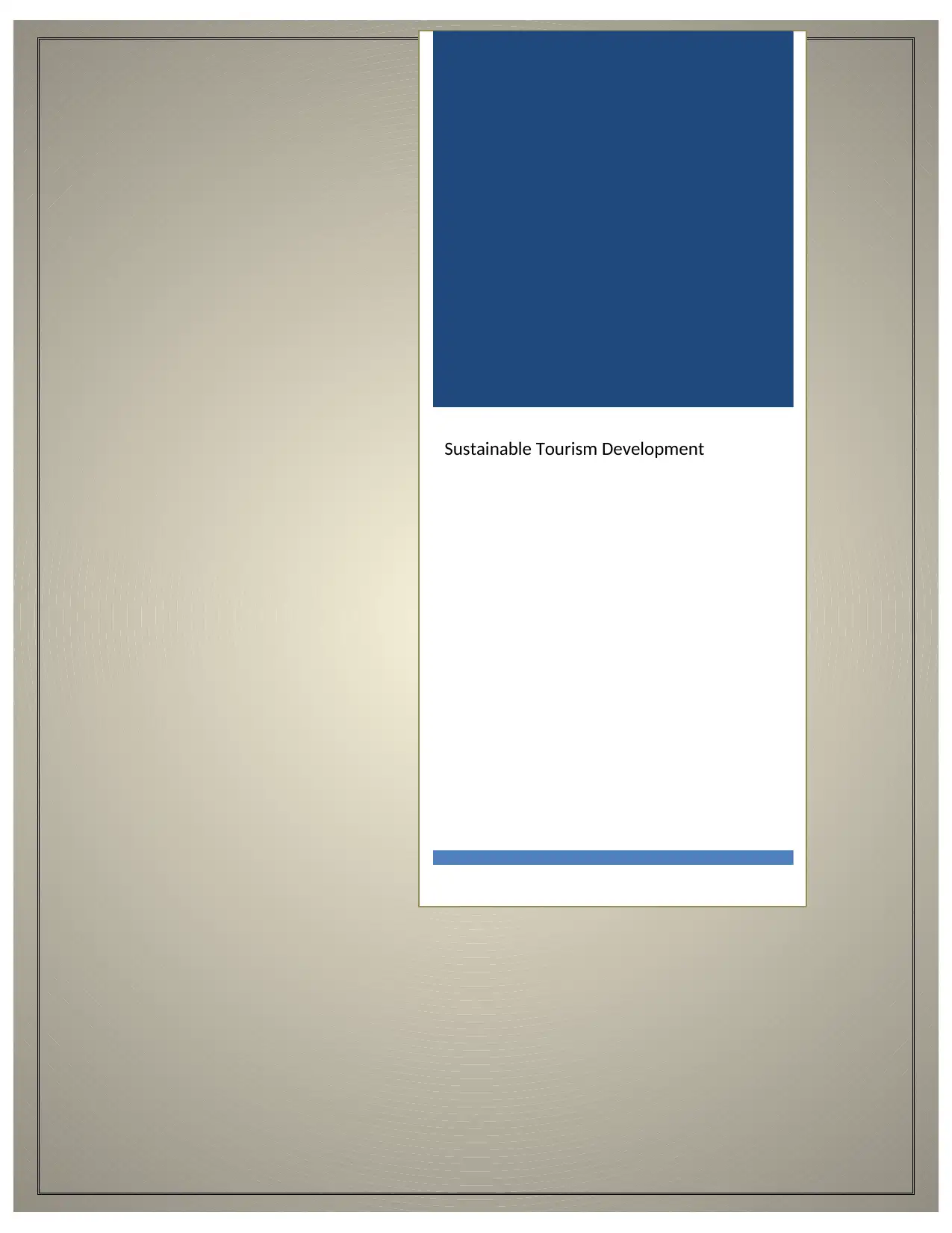
Sustainable Tourism Development
Secure Best Marks with AI Grader
Need help grading? Try our AI Grader for instant feedback on your assignments.
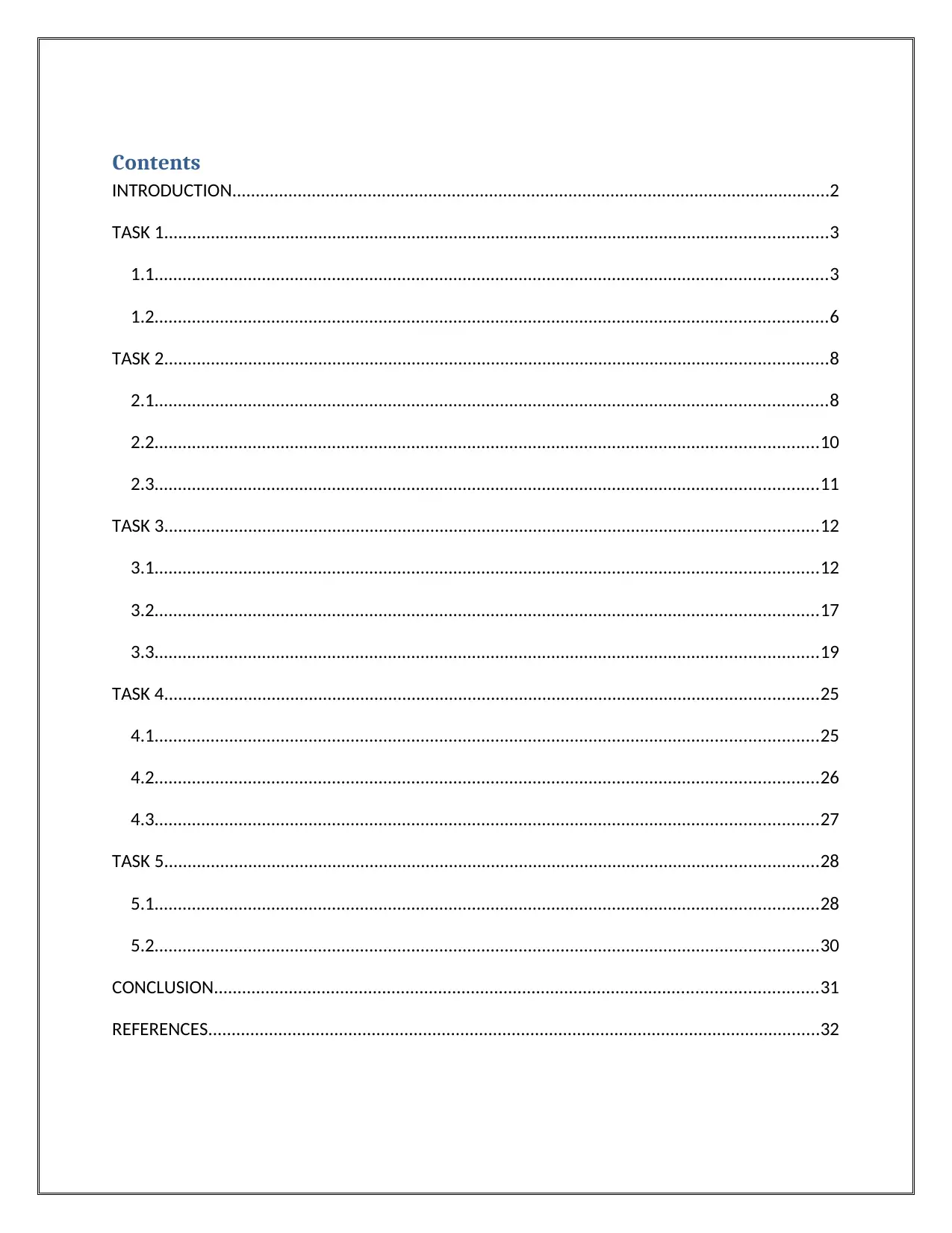
Contents
INTRODUCTION................................................................................................................................2
TASK 1..............................................................................................................................................3
1.1................................................................................................................................................3
1.2................................................................................................................................................6
TASK 2..............................................................................................................................................8
2.1................................................................................................................................................8
2.2..............................................................................................................................................10
2.3..............................................................................................................................................11
TASK 3............................................................................................................................................12
3.1..............................................................................................................................................12
3.2..............................................................................................................................................17
3.3..............................................................................................................................................19
TASK 4............................................................................................................................................25
4.1..............................................................................................................................................25
4.2..............................................................................................................................................26
4.3..............................................................................................................................................27
TASK 5............................................................................................................................................28
5.1..............................................................................................................................................28
5.2..............................................................................................................................................30
CONCLUSION.................................................................................................................................31
REFERENCES...................................................................................................................................32
INTRODUCTION................................................................................................................................2
TASK 1..............................................................................................................................................3
1.1................................................................................................................................................3
1.2................................................................................................................................................6
TASK 2..............................................................................................................................................8
2.1................................................................................................................................................8
2.2..............................................................................................................................................10
2.3..............................................................................................................................................11
TASK 3............................................................................................................................................12
3.1..............................................................................................................................................12
3.2..............................................................................................................................................17
3.3..............................................................................................................................................19
TASK 4............................................................................................................................................25
4.1..............................................................................................................................................25
4.2..............................................................................................................................................26
4.3..............................................................................................................................................27
TASK 5............................................................................................................................................28
5.1..............................................................................................................................................28
5.2..............................................................................................................................................30
CONCLUSION.................................................................................................................................31
REFERENCES...................................................................................................................................32


INTRODUCTION
Travel and Tourism has a significant role in the economic development of a country. In the
recently changing economic times, travel and tourism is the focus of many countries and it has
a significant contribution of the GDP (Moutinho and Vargas-Sanchez, 2018). This assignment
focused on the development of travel and tourism, with its advantages to the stakeholders in
the tourism industry. It also highlights the sustainable tourism and the different approaches
that used in tourism planning and development. It also helps to perceive the issues related to
tourism and the impact of the social, cultural, and economic condition of a county on the
tourism development.
Travel and Tourism has a significant role in the economic development of a country. In the
recently changing economic times, travel and tourism is the focus of many countries and it has
a significant contribution of the GDP (Moutinho and Vargas-Sanchez, 2018). This assignment
focused on the development of travel and tourism, with its advantages to the stakeholders in
the tourism industry. It also highlights the sustainable tourism and the different approaches
that used in tourism planning and development. It also helps to perceive the issues related to
tourism and the impact of the social, cultural, and economic condition of a county on the
tourism development.
Secure Best Marks with AI Grader
Need help grading? Try our AI Grader for instant feedback on your assignments.
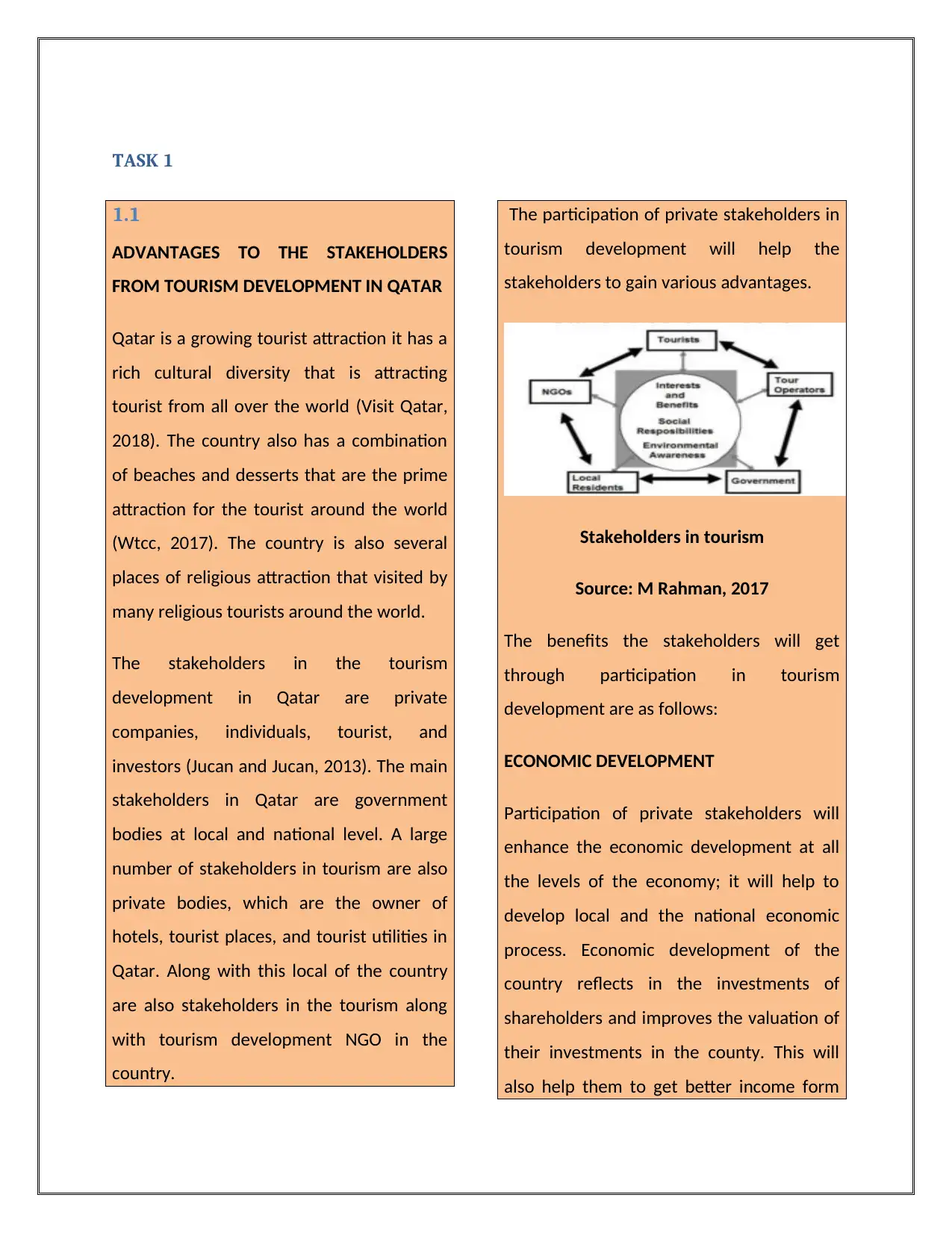
TASK 1
1.1
ADVANTAGES TO THE STAKEHOLDERS
FROM TOURISM DEVELOPMENT IN QATAR
Qatar is a growing tourist attraction it has a
rich cultural diversity that is attracting
tourist from all over the world (Visit Qatar,
2018). The country also has a combination
of beaches and desserts that are the prime
attraction for the tourist around the world
(Wtcc, 2017). The country is also several
places of religious attraction that visited by
many religious tourists around the world.
The stakeholders in the tourism
development in Qatar are private
companies, individuals, tourist, and
investors (Jucan and Jucan, 2013). The main
stakeholders in Qatar are government
bodies at local and national level. A large
number of stakeholders in tourism are also
private bodies, which are the owner of
hotels, tourist places, and tourist utilities in
Qatar. Along with this local of the country
are also stakeholders in the tourism along
with tourism development NGO in the
country.
The participation of private stakeholders in
tourism development will help the
stakeholders to gain various advantages.
Stakeholders in tourism
Source: M Rahman, 2017
The benefits the stakeholders will get
through participation in tourism
development are as follows:
ECONOMIC DEVELOPMENT
Participation of private stakeholders will
enhance the economic development at all
the levels of the economy; it will help to
develop local and the national economic
process. Economic development of the
country reflects in the investments of
shareholders and improves the valuation of
their investments in the county. This will
also help them to get better income form
1.1
ADVANTAGES TO THE STAKEHOLDERS
FROM TOURISM DEVELOPMENT IN QATAR
Qatar is a growing tourist attraction it has a
rich cultural diversity that is attracting
tourist from all over the world (Visit Qatar,
2018). The country also has a combination
of beaches and desserts that are the prime
attraction for the tourist around the world
(Wtcc, 2017). The country is also several
places of religious attraction that visited by
many religious tourists around the world.
The stakeholders in the tourism
development in Qatar are private
companies, individuals, tourist, and
investors (Jucan and Jucan, 2013). The main
stakeholders in Qatar are government
bodies at local and national level. A large
number of stakeholders in tourism are also
private bodies, which are the owner of
hotels, tourist places, and tourist utilities in
Qatar. Along with this local of the country
are also stakeholders in the tourism along
with tourism development NGO in the
country.
The participation of private stakeholders in
tourism development will help the
stakeholders to gain various advantages.
Stakeholders in tourism
Source: M Rahman, 2017
The benefits the stakeholders will get
through participation in tourism
development are as follows:
ECONOMIC DEVELOPMENT
Participation of private stakeholders will
enhance the economic development at all
the levels of the economy; it will help to
develop local and the national economic
process. Economic development of the
country reflects in the investments of
shareholders and improves the valuation of
their investments in the county. This will
also help them to get better income form
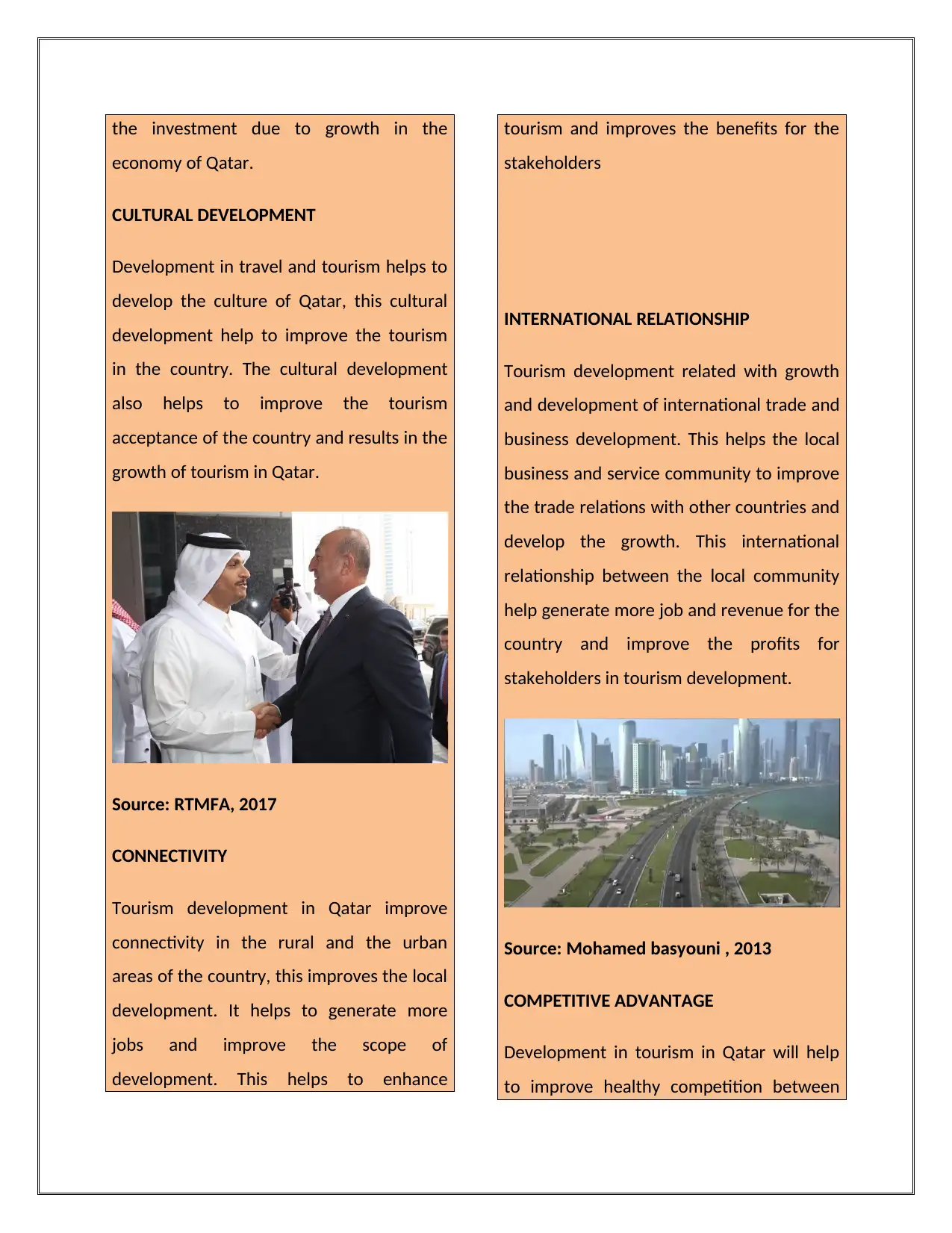
the investment due to growth in the
economy of Qatar.
CULTURAL DEVELOPMENT
Development in travel and tourism helps to
develop the culture of Qatar, this cultural
development help to improve the tourism
in the country. The cultural development
also helps to improve the tourism
acceptance of the country and results in the
growth of tourism in Qatar.
Source: RTMFA, 2017
CONNECTIVITY
Tourism development in Qatar improve
connectivity in the rural and the urban
areas of the country, this improves the local
development. It helps to generate more
jobs and improve the scope of
development. This helps to enhance
tourism and improves the benefits for the
stakeholders
INTERNATIONAL RELATIONSHIP
Tourism development related with growth
and development of international trade and
business development. This helps the local
business and service community to improve
the trade relations with other countries and
develop the growth. This international
relationship between the local community
help generate more job and revenue for the
country and improve the profits for
stakeholders in tourism development.
Source: Mohamed basyouni , 2013
COMPETITIVE ADVANTAGE
Development in tourism in Qatar will help
to improve healthy competition between
economy of Qatar.
CULTURAL DEVELOPMENT
Development in travel and tourism helps to
develop the culture of Qatar, this cultural
development help to improve the tourism
in the country. The cultural development
also helps to improve the tourism
acceptance of the country and results in the
growth of tourism in Qatar.
Source: RTMFA, 2017
CONNECTIVITY
Tourism development in Qatar improve
connectivity in the rural and the urban
areas of the country, this improves the local
development. It helps to generate more
jobs and improve the scope of
development. This helps to enhance
tourism and improves the benefits for the
stakeholders
INTERNATIONAL RELATIONSHIP
Tourism development related with growth
and development of international trade and
business development. This helps the local
business and service community to improve
the trade relations with other countries and
develop the growth. This international
relationship between the local community
help generate more job and revenue for the
country and improve the profits for
stakeholders in tourism development.
Source: Mohamed basyouni , 2013
COMPETITIVE ADVANTAGE
Development in tourism in Qatar will help
to improve healthy competition between
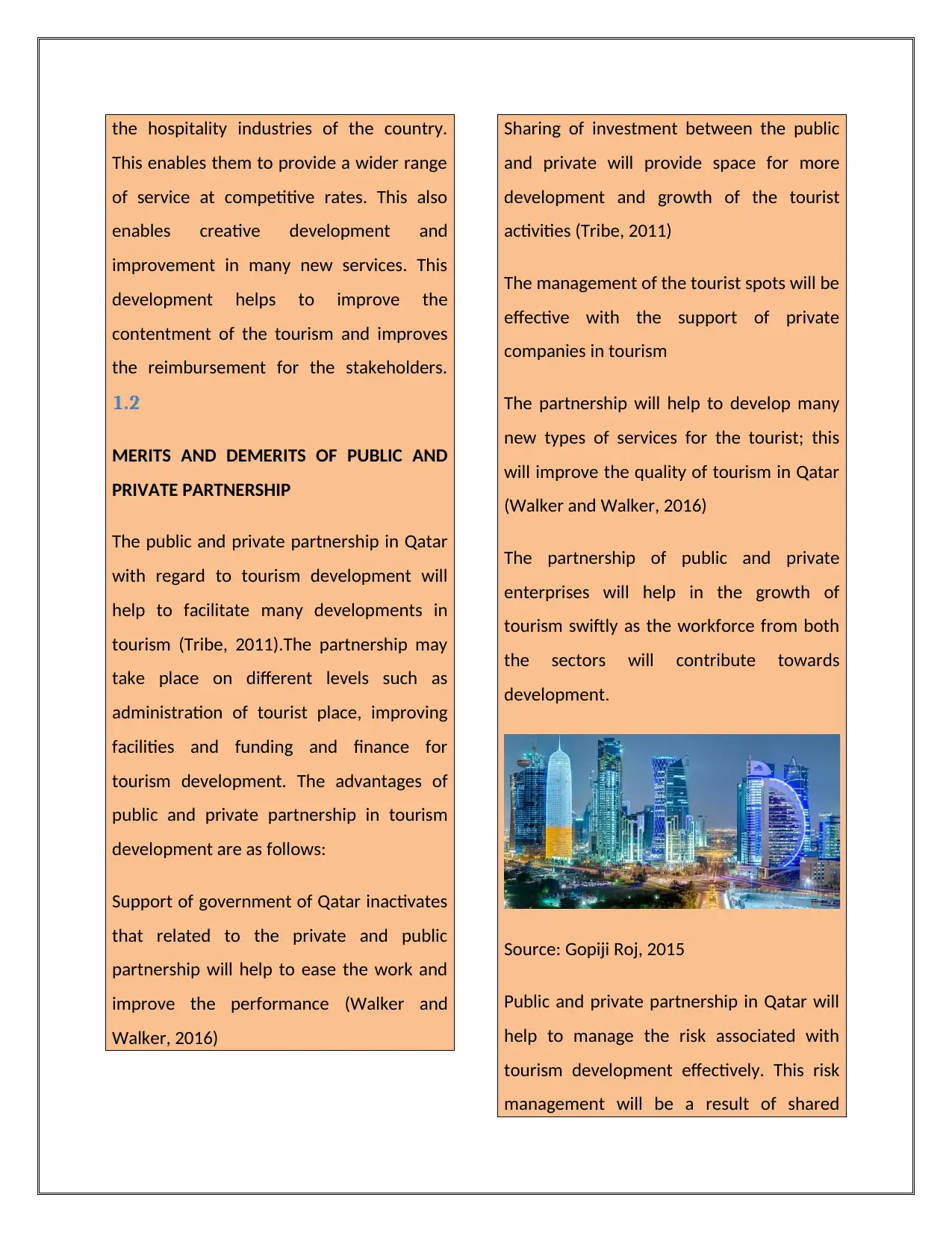
the hospitality industries of the country.
This enables them to provide a wider range
of service at competitive rates. This also
enables creative development and
improvement in many new services. This
development helps to improve the
contentment of the tourism and improves
the reimbursement for the stakeholders.
1.2
MERITS AND DEMERITS OF PUBLIC AND
PRIVATE PARTNERSHIP
The public and private partnership in Qatar
with regard to tourism development will
help to facilitate many developments in
tourism (Tribe, 2011).The partnership may
take place on different levels such as
administration of tourist place, improving
facilities and funding and finance for
tourism development. The advantages of
public and private partnership in tourism
development are as follows:
Support of government of Qatar inactivates
that related to the private and public
partnership will help to ease the work and
improve the performance (Walker and
Walker, 2016)
Sharing of investment between the public
and private will provide space for more
development and growth of the tourist
activities (Tribe, 2011)
The management of the tourist spots will be
effective with the support of private
companies in tourism
The partnership will help to develop many
new types of services for the tourist; this
will improve the quality of tourism in Qatar
(Walker and Walker, 2016)
The partnership of public and private
enterprises will help in the growth of
tourism swiftly as the workforce from both
the sectors will contribute towards
development.
Source: Gopiji Roj, 2015
Public and private partnership in Qatar will
help to manage the risk associated with
tourism development effectively. This risk
management will be a result of shared
This enables them to provide a wider range
of service at competitive rates. This also
enables creative development and
improvement in many new services. This
development helps to improve the
contentment of the tourism and improves
the reimbursement for the stakeholders.
1.2
MERITS AND DEMERITS OF PUBLIC AND
PRIVATE PARTNERSHIP
The public and private partnership in Qatar
with regard to tourism development will
help to facilitate many developments in
tourism (Tribe, 2011).The partnership may
take place on different levels such as
administration of tourist place, improving
facilities and funding and finance for
tourism development. The advantages of
public and private partnership in tourism
development are as follows:
Support of government of Qatar inactivates
that related to the private and public
partnership will help to ease the work and
improve the performance (Walker and
Walker, 2016)
Sharing of investment between the public
and private will provide space for more
development and growth of the tourist
activities (Tribe, 2011)
The management of the tourist spots will be
effective with the support of private
companies in tourism
The partnership will help to develop many
new types of services for the tourist; this
will improve the quality of tourism in Qatar
(Walker and Walker, 2016)
The partnership of public and private
enterprises will help in the growth of
tourism swiftly as the workforce from both
the sectors will contribute towards
development.
Source: Gopiji Roj, 2015
Public and private partnership in Qatar will
help to manage the risk associated with
tourism development effectively. This risk
management will be a result of shared
Paraphrase This Document
Need a fresh take? Get an instant paraphrase of this document with our AI Paraphraser
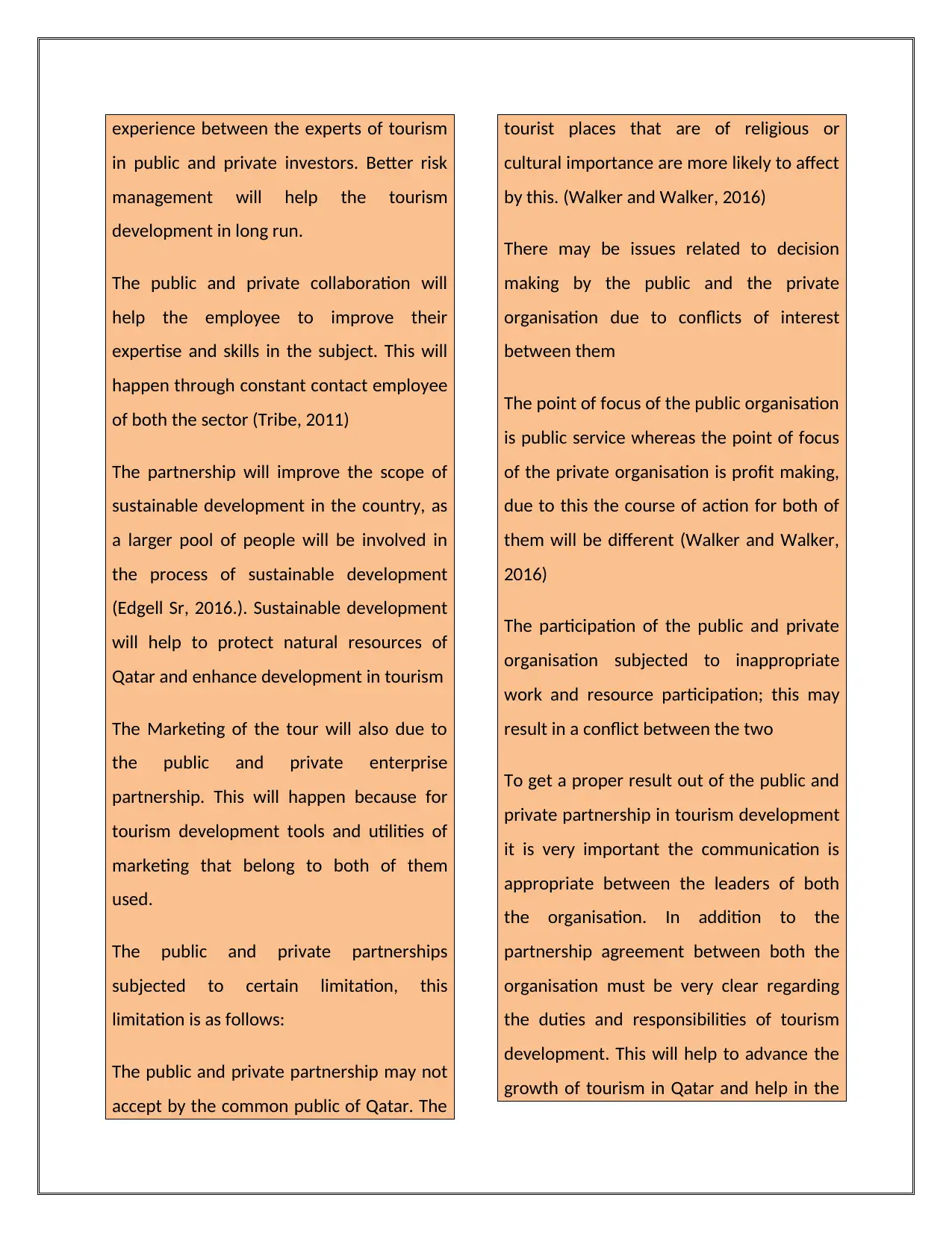
experience between the experts of tourism
in public and private investors. Better risk
management will help the tourism
development in long run.
The public and private collaboration will
help the employee to improve their
expertise and skills in the subject. This will
happen through constant contact employee
of both the sector (Tribe, 2011)
The partnership will improve the scope of
sustainable development in the country, as
a larger pool of people will be involved in
the process of sustainable development
(Edgell Sr, 2016.). Sustainable development
will help to protect natural resources of
Qatar and enhance development in tourism
The Marketing of the tour will also due to
the public and private enterprise
partnership. This will happen because for
tourism development tools and utilities of
marketing that belong to both of them
used.
The public and private partnerships
subjected to certain limitation, this
limitation is as follows:
The public and private partnership may not
accept by the common public of Qatar. The
tourist places that are of religious or
cultural importance are more likely to affect
by this. (Walker and Walker, 2016)
There may be issues related to decision
making by the public and the private
organisation due to conflicts of interest
between them
The point of focus of the public organisation
is public service whereas the point of focus
of the private organisation is profit making,
due to this the course of action for both of
them will be different (Walker and Walker,
2016)
The participation of the public and private
organisation subjected to inappropriate
work and resource participation; this may
result in a conflict between the two
To get a proper result out of the public and
private partnership in tourism development
it is very important the communication is
appropriate between the leaders of both
the organisation. In addition to the
partnership agreement between both the
organisation must be very clear regarding
the duties and responsibilities of tourism
development. This will help to advance the
growth of tourism in Qatar and help in the
in public and private investors. Better risk
management will help the tourism
development in long run.
The public and private collaboration will
help the employee to improve their
expertise and skills in the subject. This will
happen through constant contact employee
of both the sector (Tribe, 2011)
The partnership will improve the scope of
sustainable development in the country, as
a larger pool of people will be involved in
the process of sustainable development
(Edgell Sr, 2016.). Sustainable development
will help to protect natural resources of
Qatar and enhance development in tourism
The Marketing of the tour will also due to
the public and private enterprise
partnership. This will happen because for
tourism development tools and utilities of
marketing that belong to both of them
used.
The public and private partnerships
subjected to certain limitation, this
limitation is as follows:
The public and private partnership may not
accept by the common public of Qatar. The
tourist places that are of religious or
cultural importance are more likely to affect
by this. (Walker and Walker, 2016)
There may be issues related to decision
making by the public and the private
organisation due to conflicts of interest
between them
The point of focus of the public organisation
is public service whereas the point of focus
of the private organisation is profit making,
due to this the course of action for both of
them will be different (Walker and Walker,
2016)
The participation of the public and private
organisation subjected to inappropriate
work and resource participation; this may
result in a conflict between the two
To get a proper result out of the public and
private partnership in tourism development
it is very important the communication is
appropriate between the leaders of both
the organisation. In addition to the
partnership agreement between both the
organisation must be very clear regarding
the duties and responsibilities of tourism
development. This will help to advance the
growth of tourism in Qatar and help in the
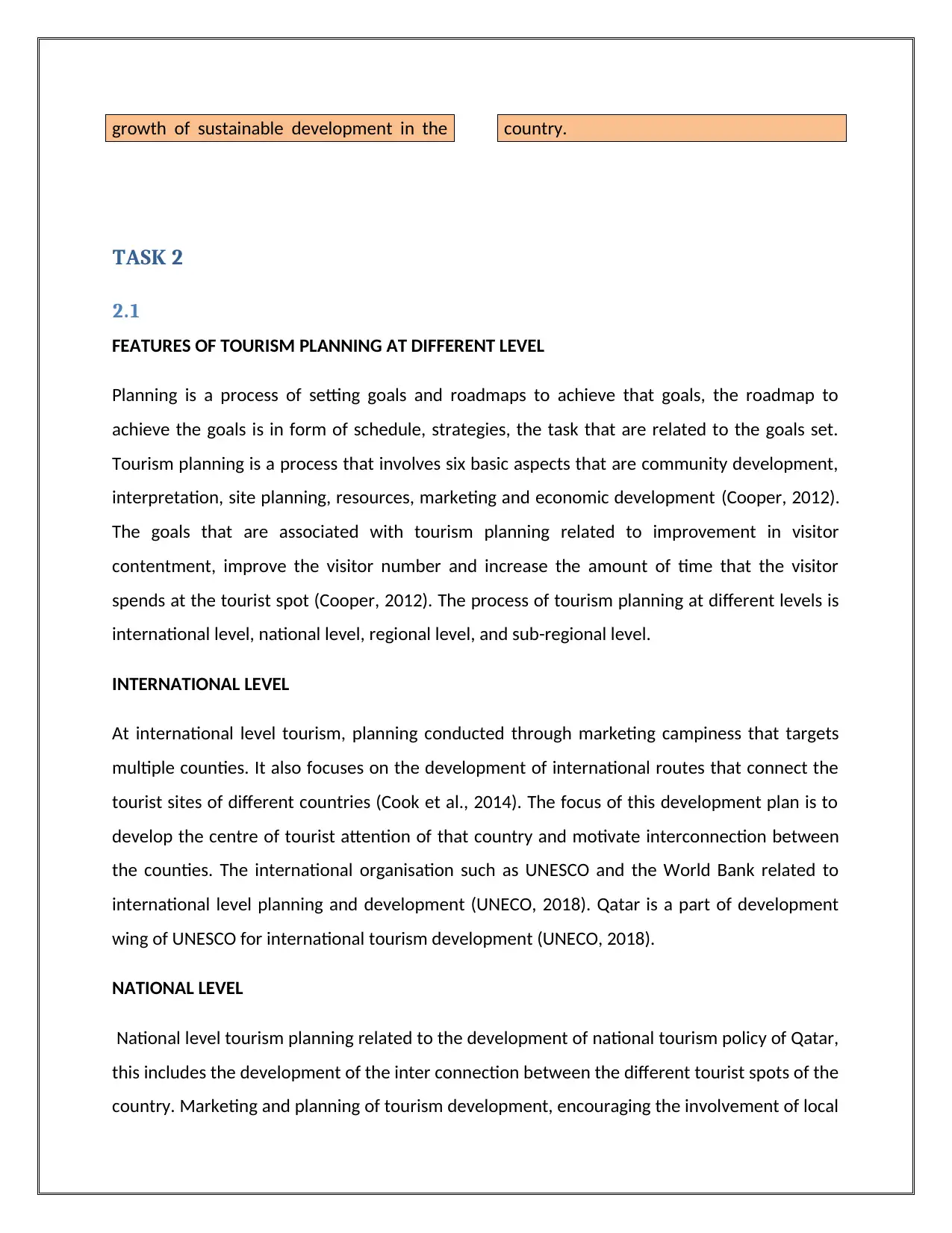
growth of sustainable development in the country.
TASK 2
2.1
FEATURES OF TOURISM PLANNING AT DIFFERENT LEVEL
Planning is a process of setting goals and roadmaps to achieve that goals, the roadmap to
achieve the goals is in form of schedule, strategies, the task that are related to the goals set.
Tourism planning is a process that involves six basic aspects that are community development,
interpretation, site planning, resources, marketing and economic development (Cooper, 2012).
The goals that are associated with tourism planning related to improvement in visitor
contentment, improve the visitor number and increase the amount of time that the visitor
spends at the tourist spot (Cooper, 2012). The process of tourism planning at different levels is
international level, national level, regional level, and sub-regional level.
INTERNATIONAL LEVEL
At international level tourism, planning conducted through marketing campiness that targets
multiple counties. It also focuses on the development of international routes that connect the
tourist sites of different countries (Cook et al., 2014). The focus of this development plan is to
develop the centre of tourist attention of that country and motivate interconnection between
the counties. The international organisation such as UNESCO and the World Bank related to
international level planning and development (UNECO, 2018). Qatar is a part of development
wing of UNESCO for international tourism development (UNECO, 2018).
NATIONAL LEVEL
National level tourism planning related to the development of national tourism policy of Qatar,
this includes the development of the inter connection between the different tourist spots of the
country. Marketing and planning of tourism development, encouraging the involvement of local
TASK 2
2.1
FEATURES OF TOURISM PLANNING AT DIFFERENT LEVEL
Planning is a process of setting goals and roadmaps to achieve that goals, the roadmap to
achieve the goals is in form of schedule, strategies, the task that are related to the goals set.
Tourism planning is a process that involves six basic aspects that are community development,
interpretation, site planning, resources, marketing and economic development (Cooper, 2012).
The goals that are associated with tourism planning related to improvement in visitor
contentment, improve the visitor number and increase the amount of time that the visitor
spends at the tourist spot (Cooper, 2012). The process of tourism planning at different levels is
international level, national level, regional level, and sub-regional level.
INTERNATIONAL LEVEL
At international level tourism, planning conducted through marketing campiness that targets
multiple counties. It also focuses on the development of international routes that connect the
tourist sites of different countries (Cook et al., 2014). The focus of this development plan is to
develop the centre of tourist attention of that country and motivate interconnection between
the counties. The international organisation such as UNESCO and the World Bank related to
international level planning and development (UNECO, 2018). Qatar is a part of development
wing of UNESCO for international tourism development (UNECO, 2018).
NATIONAL LEVEL
National level tourism planning related to the development of national tourism policy of Qatar,
this includes the development of the inter connection between the different tourist spots of the
country. Marketing and planning of tourism development, encouraging the involvement of local
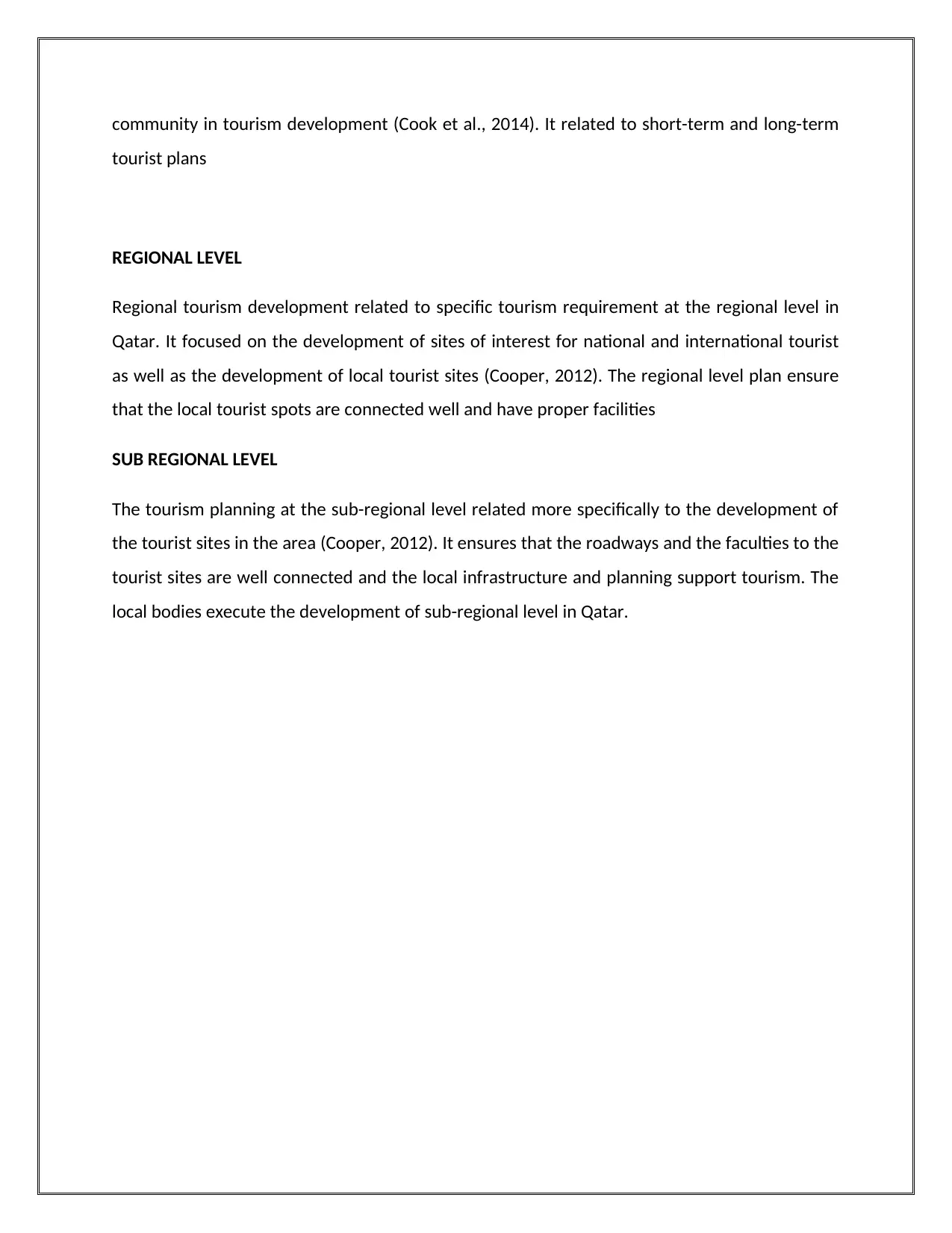
community in tourism development (Cook et al., 2014). It related to short-term and long-term
tourist plans
REGIONAL LEVEL
Regional tourism development related to specific tourism requirement at the regional level in
Qatar. It focused on the development of sites of interest for national and international tourist
as well as the development of local tourist sites (Cooper, 2012). The regional level plan ensure
that the local tourist spots are connected well and have proper facilities
SUB REGIONAL LEVEL
The tourism planning at the sub-regional level related more specifically to the development of
the tourist sites in the area (Cooper, 2012). It ensures that the roadways and the faculties to the
tourist sites are well connected and the local infrastructure and planning support tourism. The
local bodies execute the development of sub-regional level in Qatar.
tourist plans
REGIONAL LEVEL
Regional tourism development related to specific tourism requirement at the regional level in
Qatar. It focused on the development of sites of interest for national and international tourist
as well as the development of local tourist sites (Cooper, 2012). The regional level plan ensure
that the local tourist spots are connected well and have proper facilities
SUB REGIONAL LEVEL
The tourism planning at the sub-regional level related more specifically to the development of
the tourist sites in the area (Cooper, 2012). It ensures that the roadways and the faculties to the
tourist sites are well connected and the local infrastructure and planning support tourism. The
local bodies execute the development of sub-regional level in Qatar.
Secure Best Marks with AI Grader
Need help grading? Try our AI Grader for instant feedback on your assignments.
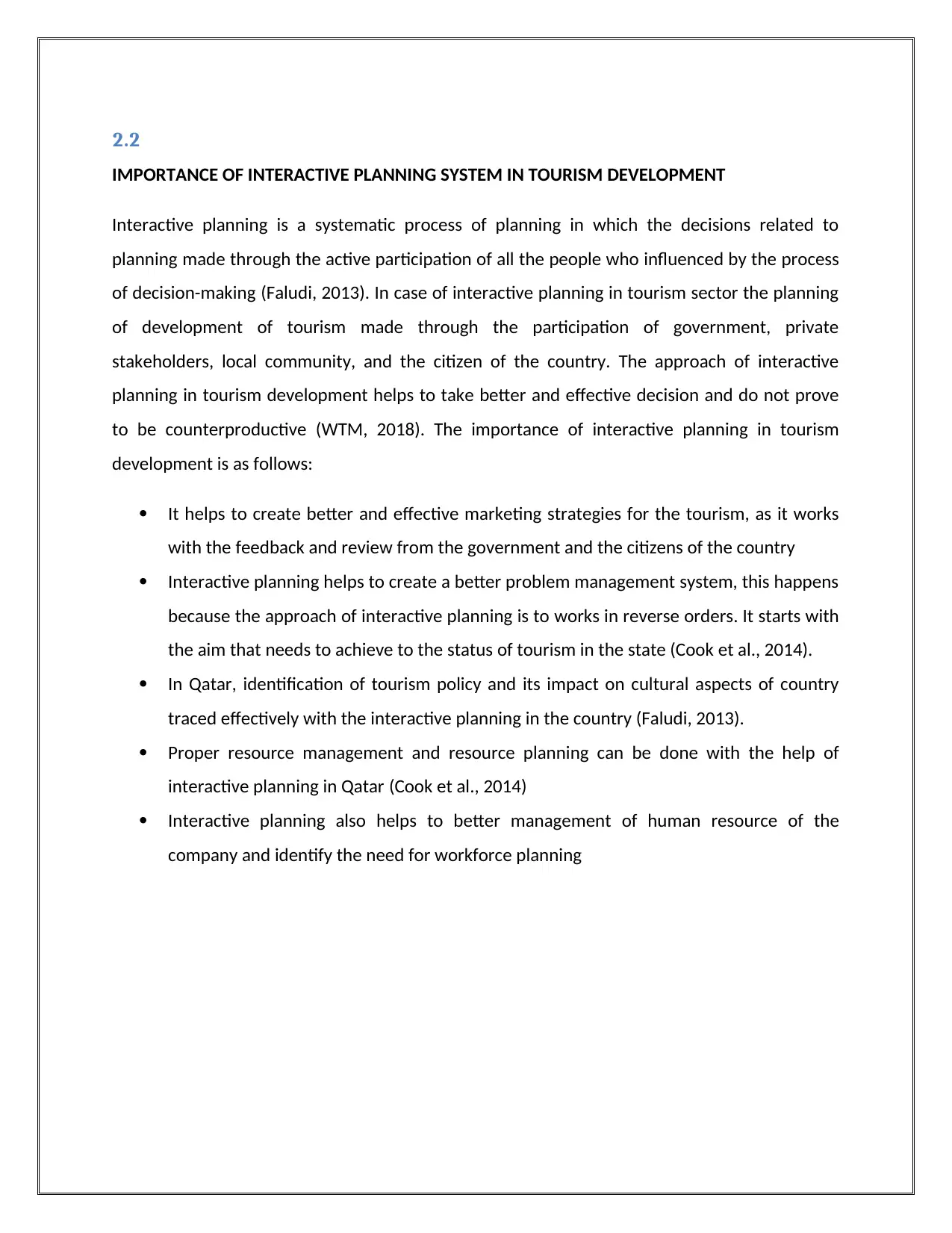
2.2
IMPORTANCE OF INTERACTIVE PLANNING SYSTEM IN TOURISM DEVELOPMENT
Interactive planning is a systematic process of planning in which the decisions related to
planning made through the active participation of all the people who influenced by the process
of decision-making (Faludi, 2013). In case of interactive planning in tourism sector the planning
of development of tourism made through the participation of government, private
stakeholders, local community, and the citizen of the country. The approach of interactive
planning in tourism development helps to take better and effective decision and do not prove
to be counterproductive (WTM, 2018). The importance of interactive planning in tourism
development is as follows:
It helps to create better and effective marketing strategies for the tourism, as it works
with the feedback and review from the government and the citizens of the country
Interactive planning helps to create a better problem management system, this happens
because the approach of interactive planning is to works in reverse orders. It starts with
the aim that needs to achieve to the status of tourism in the state (Cook et al., 2014).
In Qatar, identification of tourism policy and its impact on cultural aspects of country
traced effectively with the interactive planning in the country (Faludi, 2013).
Proper resource management and resource planning can be done with the help of
interactive planning in Qatar (Cook et al., 2014)
Interactive planning also helps to better management of human resource of the
company and identify the need for workforce planning
IMPORTANCE OF INTERACTIVE PLANNING SYSTEM IN TOURISM DEVELOPMENT
Interactive planning is a systematic process of planning in which the decisions related to
planning made through the active participation of all the people who influenced by the process
of decision-making (Faludi, 2013). In case of interactive planning in tourism sector the planning
of development of tourism made through the participation of government, private
stakeholders, local community, and the citizen of the country. The approach of interactive
planning in tourism development helps to take better and effective decision and do not prove
to be counterproductive (WTM, 2018). The importance of interactive planning in tourism
development is as follows:
It helps to create better and effective marketing strategies for the tourism, as it works
with the feedback and review from the government and the citizens of the country
Interactive planning helps to create a better problem management system, this happens
because the approach of interactive planning is to works in reverse orders. It starts with
the aim that needs to achieve to the status of tourism in the state (Cook et al., 2014).
In Qatar, identification of tourism policy and its impact on cultural aspects of country
traced effectively with the interactive planning in the country (Faludi, 2013).
Proper resource management and resource planning can be done with the help of
interactive planning in Qatar (Cook et al., 2014)
Interactive planning also helps to better management of human resource of the
company and identify the need for workforce planning
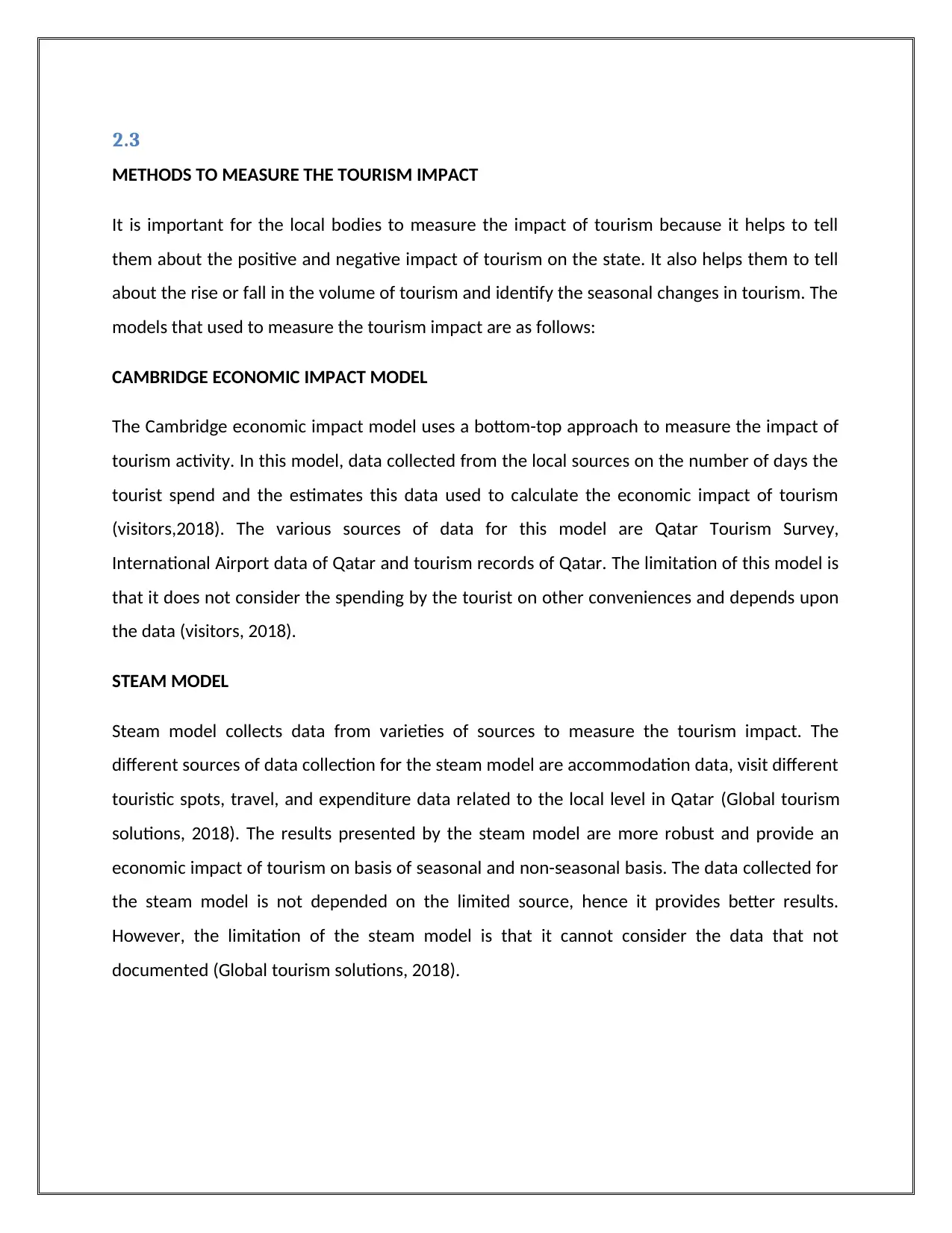
2.3
METHODS TO MEASURE THE TOURISM IMPACT
It is important for the local bodies to measure the impact of tourism because it helps to tell
them about the positive and negative impact of tourism on the state. It also helps them to tell
about the rise or fall in the volume of tourism and identify the seasonal changes in tourism. The
models that used to measure the tourism impact are as follows:
CAMBRIDGE ECONOMIC IMPACT MODEL
The Cambridge economic impact model uses a bottom-top approach to measure the impact of
tourism activity. In this model, data collected from the local sources on the number of days the
tourist spend and the estimates this data used to calculate the economic impact of tourism
(visitors,2018). The various sources of data for this model are Qatar Tourism Survey,
International Airport data of Qatar and tourism records of Qatar. The limitation of this model is
that it does not consider the spending by the tourist on other conveniences and depends upon
the data (visitors, 2018).
STEAM MODEL
Steam model collects data from varieties of sources to measure the tourism impact. The
different sources of data collection for the steam model are accommodation data, visit different
touristic spots, travel, and expenditure data related to the local level in Qatar (Global tourism
solutions, 2018). The results presented by the steam model are more robust and provide an
economic impact of tourism on basis of seasonal and non-seasonal basis. The data collected for
the steam model is not depended on the limited source, hence it provides better results.
However, the limitation of the steam model is that it cannot consider the data that not
documented (Global tourism solutions, 2018).
METHODS TO MEASURE THE TOURISM IMPACT
It is important for the local bodies to measure the impact of tourism because it helps to tell
them about the positive and negative impact of tourism on the state. It also helps them to tell
about the rise or fall in the volume of tourism and identify the seasonal changes in tourism. The
models that used to measure the tourism impact are as follows:
CAMBRIDGE ECONOMIC IMPACT MODEL
The Cambridge economic impact model uses a bottom-top approach to measure the impact of
tourism activity. In this model, data collected from the local sources on the number of days the
tourist spend and the estimates this data used to calculate the economic impact of tourism
(visitors,2018). The various sources of data for this model are Qatar Tourism Survey,
International Airport data of Qatar and tourism records of Qatar. The limitation of this model is
that it does not consider the spending by the tourist on other conveniences and depends upon
the data (visitors, 2018).
STEAM MODEL
Steam model collects data from varieties of sources to measure the tourism impact. The
different sources of data collection for the steam model are accommodation data, visit different
touristic spots, travel, and expenditure data related to the local level in Qatar (Global tourism
solutions, 2018). The results presented by the steam model are more robust and provide an
economic impact of tourism on basis of seasonal and non-seasonal basis. The data collected for
the steam model is not depended on the limited source, hence it provides better results.
However, the limitation of the steam model is that it cannot consider the data that not
documented (Global tourism solutions, 2018).
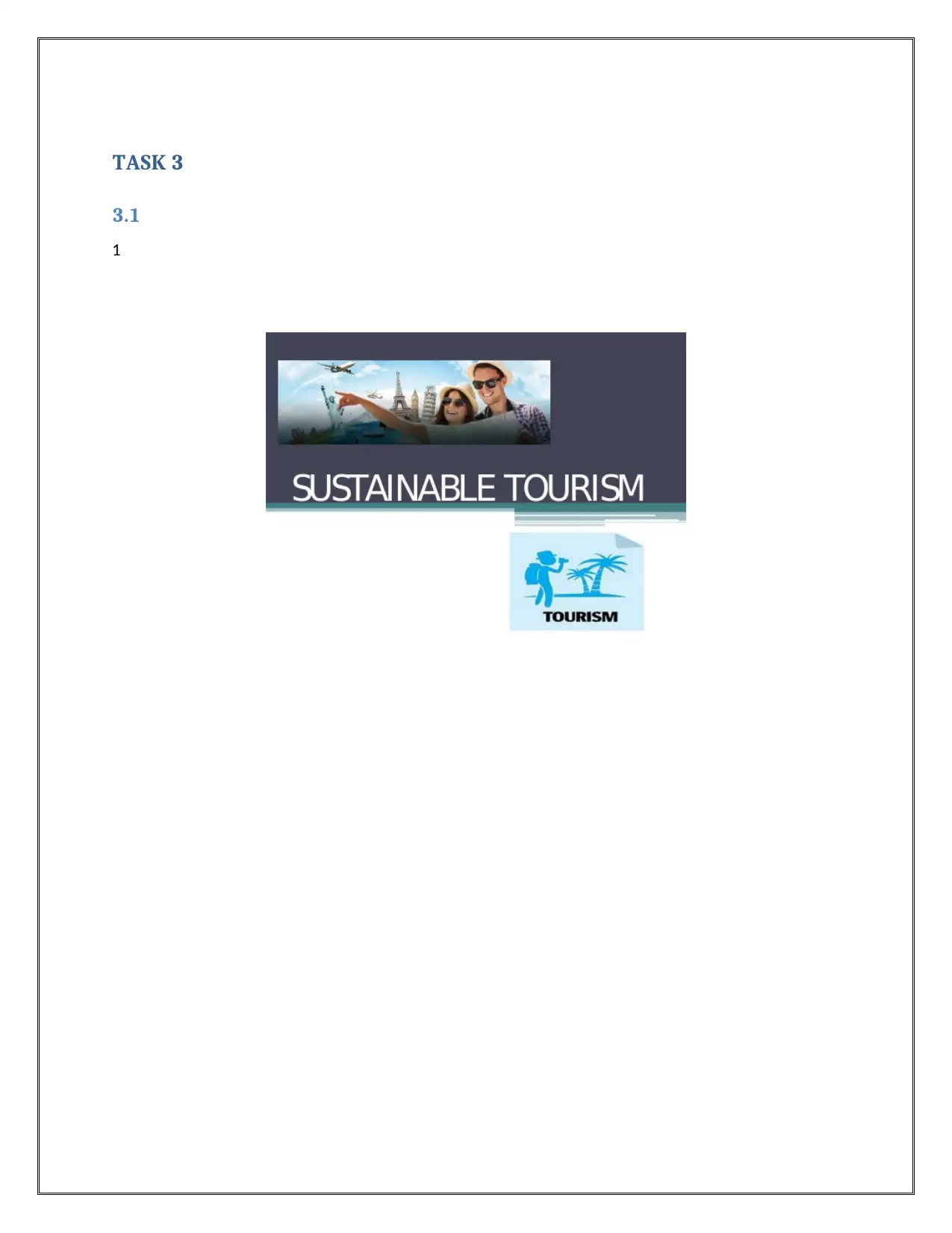
TASK 3
3.1
1
3.1
1
Paraphrase This Document
Need a fresh take? Get an instant paraphrase of this document with our AI Paraphraser
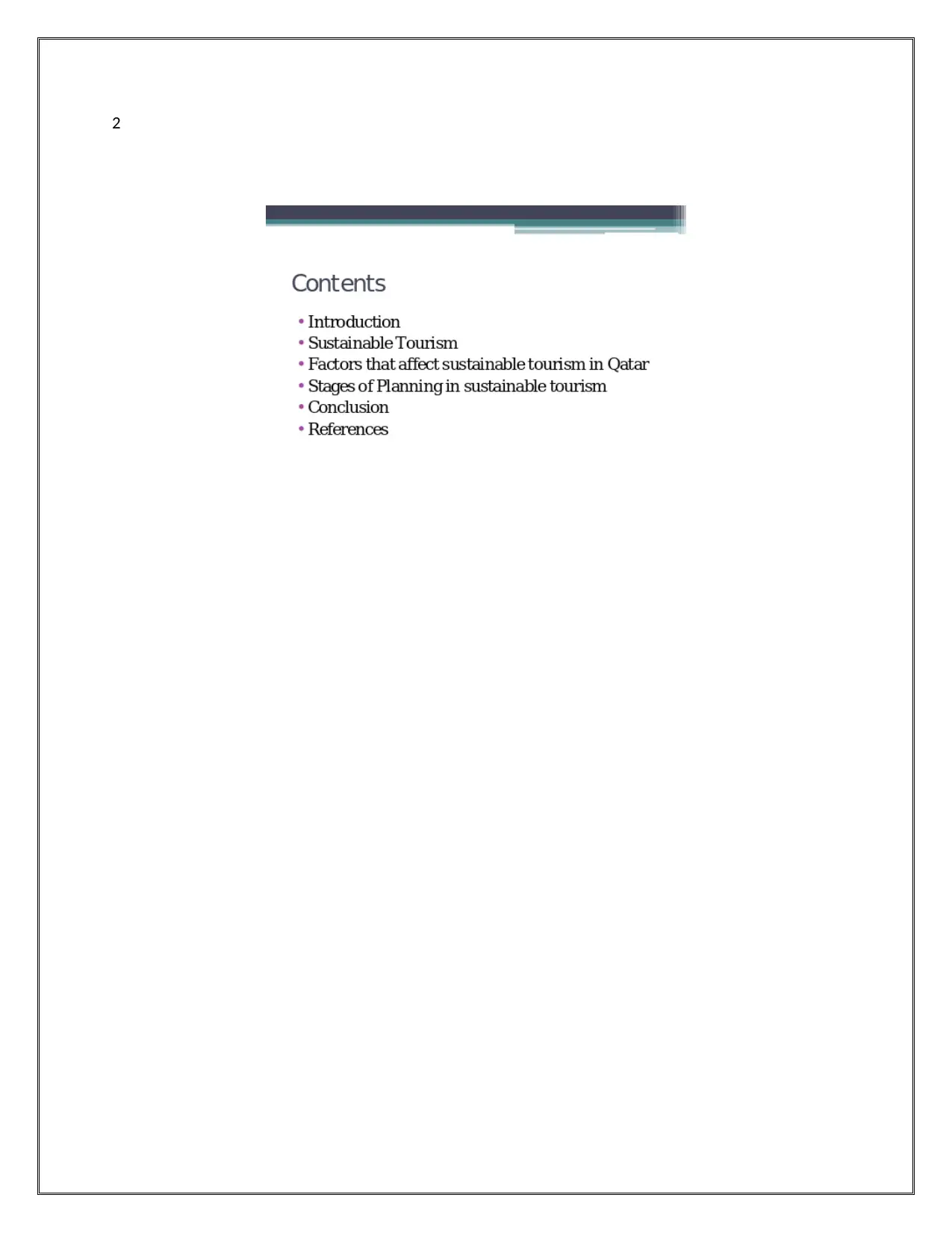
2
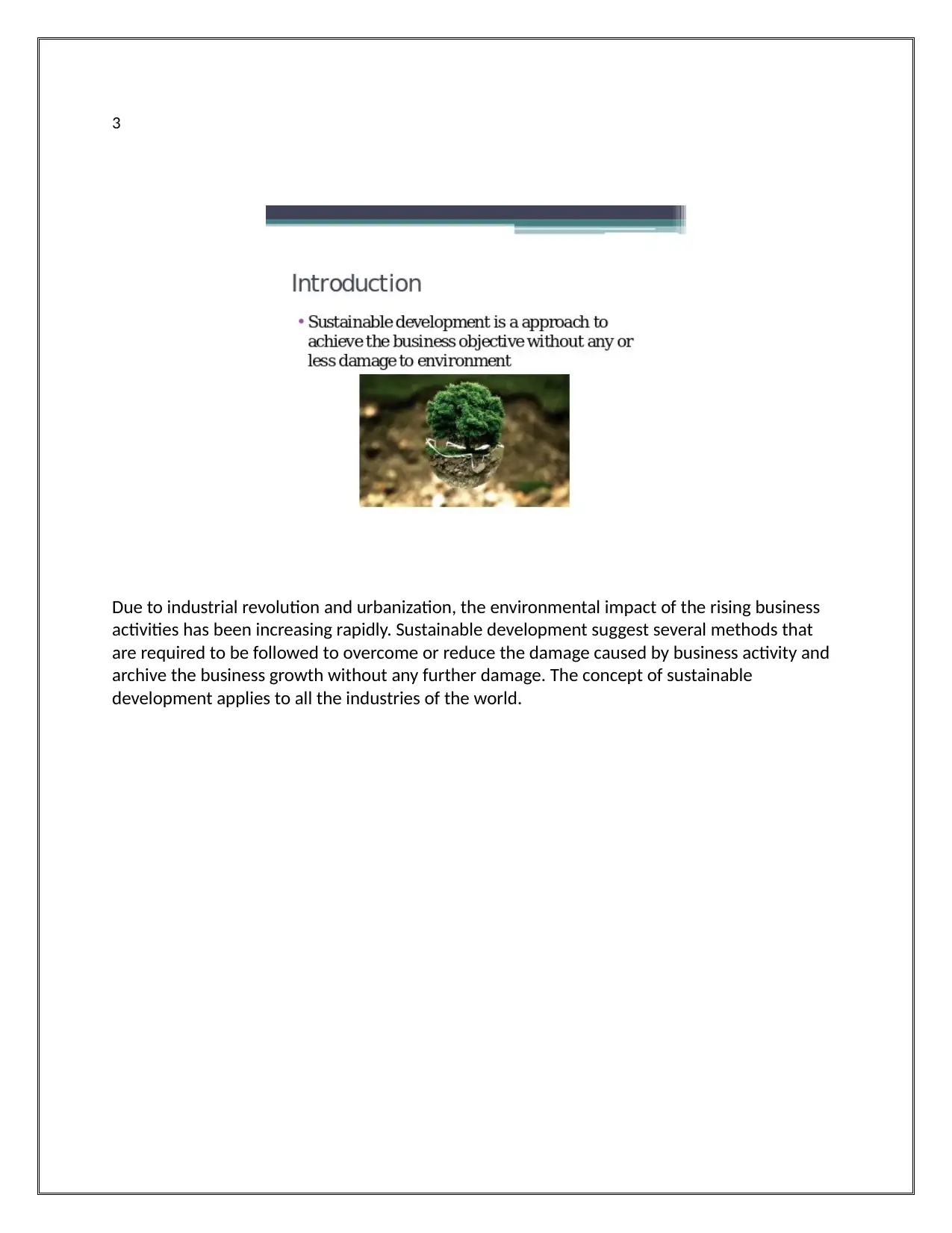
3
Due to industrial revolution and urbanization, the environmental impact of the rising business
activities has been increasing rapidly. Sustainable development suggest several methods that
are required to be followed to overcome or reduce the damage caused by business activity and
archive the business growth without any further damage. The concept of sustainable
development applies to all the industries of the world.
Due to industrial revolution and urbanization, the environmental impact of the rising business
activities has been increasing rapidly. Sustainable development suggest several methods that
are required to be followed to overcome or reduce the damage caused by business activity and
archive the business growth without any further damage. The concept of sustainable
development applies to all the industries of the world.
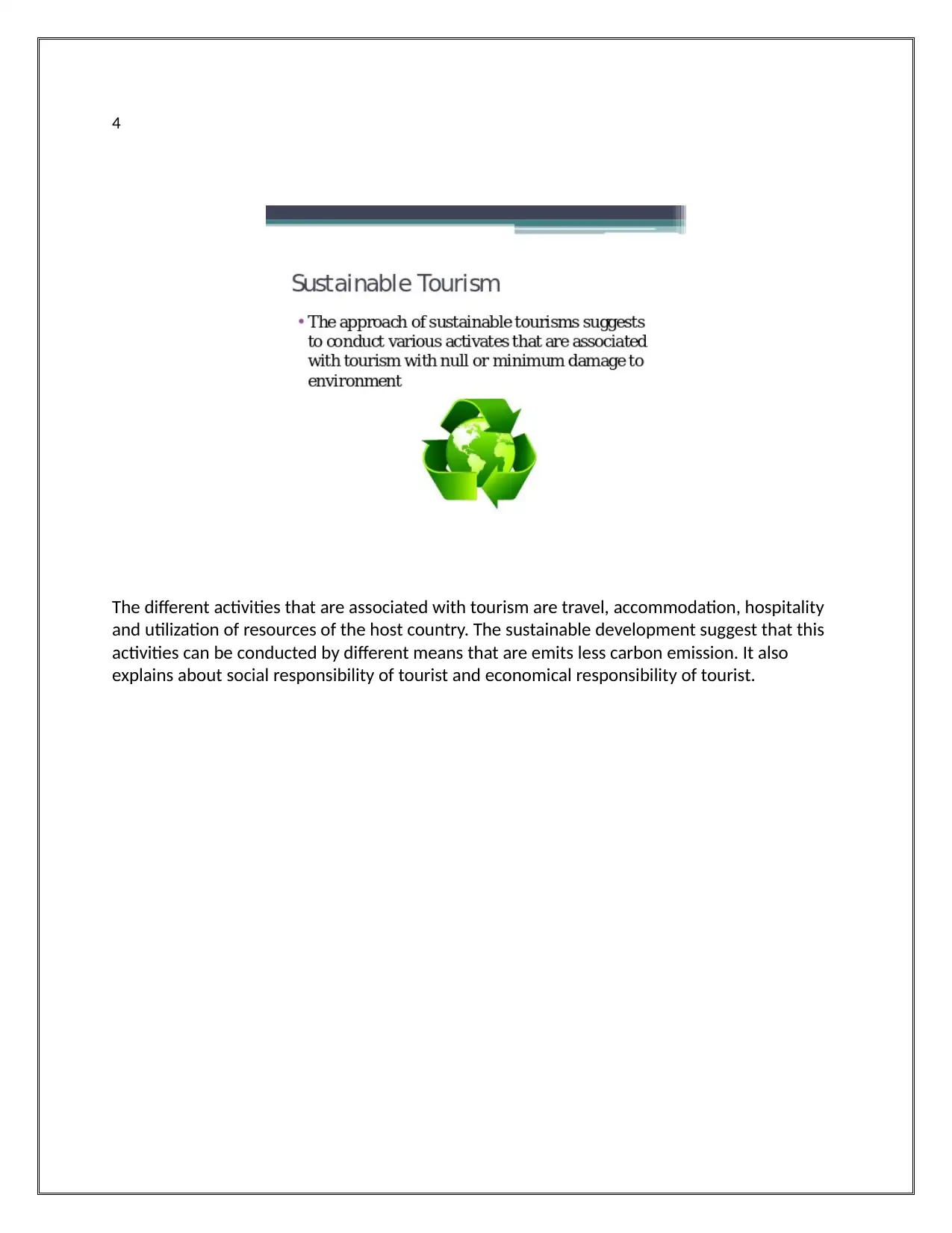
4
The different activities that are associated with tourism are travel, accommodation, hospitality
and utilization of resources of the host country. The sustainable development suggest that this
activities can be conducted by different means that are emits less carbon emission. It also
explains about social responsibility of tourist and economical responsibility of tourist.
The different activities that are associated with tourism are travel, accommodation, hospitality
and utilization of resources of the host country. The sustainable development suggest that this
activities can be conducted by different means that are emits less carbon emission. It also
explains about social responsibility of tourist and economical responsibility of tourist.
Secure Best Marks with AI Grader
Need help grading? Try our AI Grader for instant feedback on your assignments.
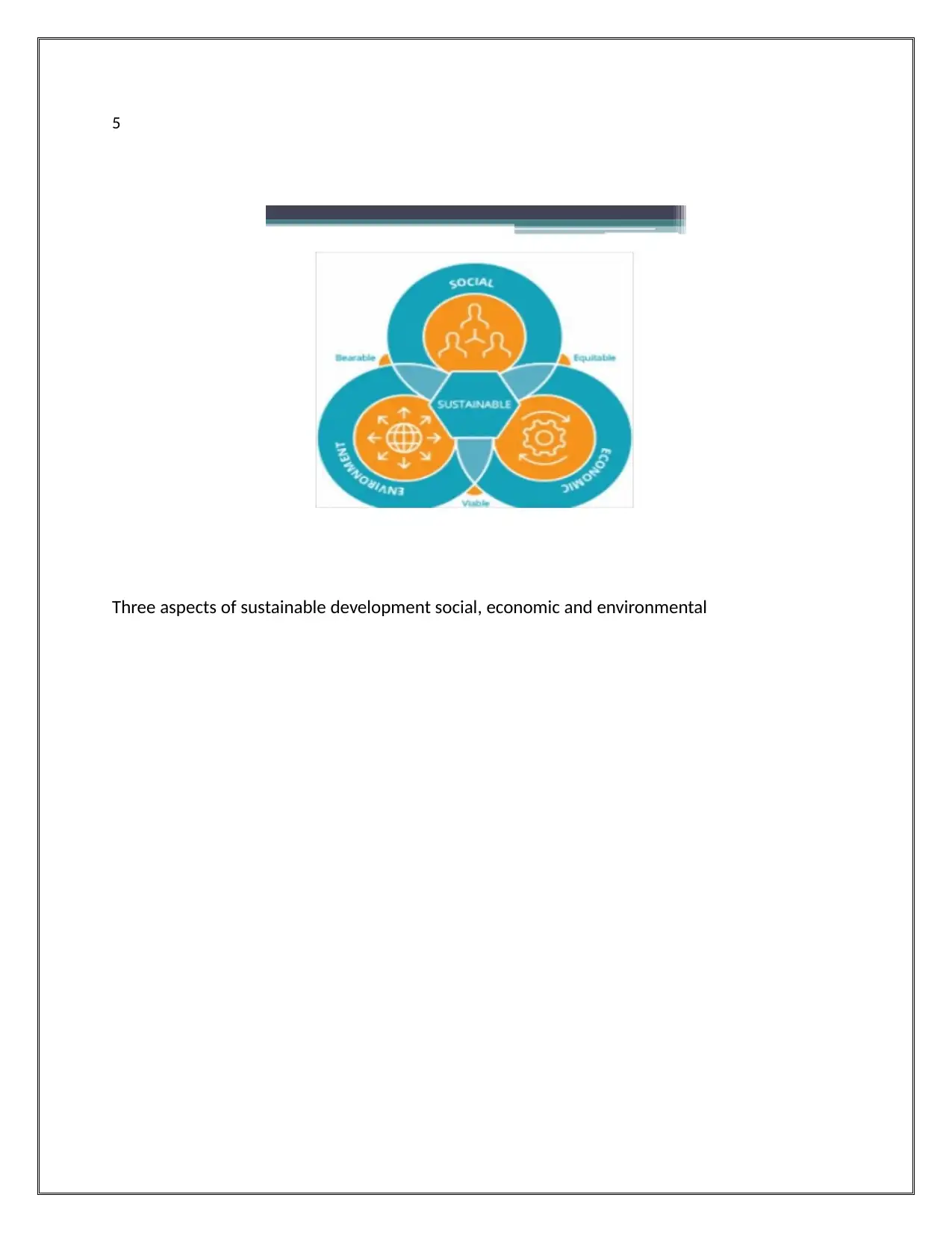
5
Three aspects of sustainable development social, economic and environmental
Three aspects of sustainable development social, economic and environmental
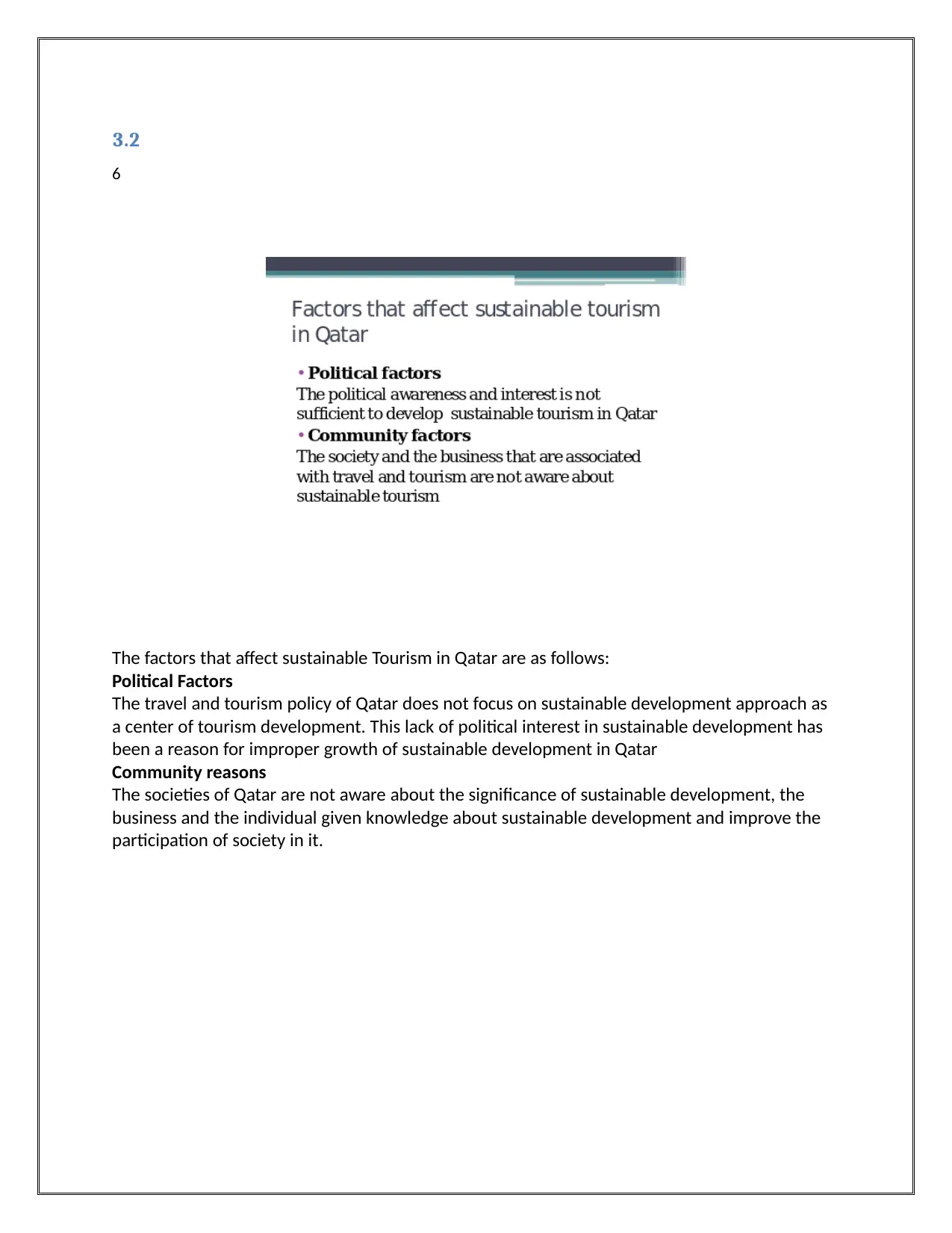
3.2
6
The factors that affect sustainable Tourism in Qatar are as follows:
Political Factors
The travel and tourism policy of Qatar does not focus on sustainable development approach as
a center of tourism development. This lack of political interest in sustainable development has
been a reason for improper growth of sustainable development in Qatar
Community reasons
The societies of Qatar are not aware about the significance of sustainable development, the
business and the individual given knowledge about sustainable development and improve the
participation of society in it.
6
The factors that affect sustainable Tourism in Qatar are as follows:
Political Factors
The travel and tourism policy of Qatar does not focus on sustainable development approach as
a center of tourism development. This lack of political interest in sustainable development has
been a reason for improper growth of sustainable development in Qatar
Community reasons
The societies of Qatar are not aware about the significance of sustainable development, the
business and the individual given knowledge about sustainable development and improve the
participation of society in it.
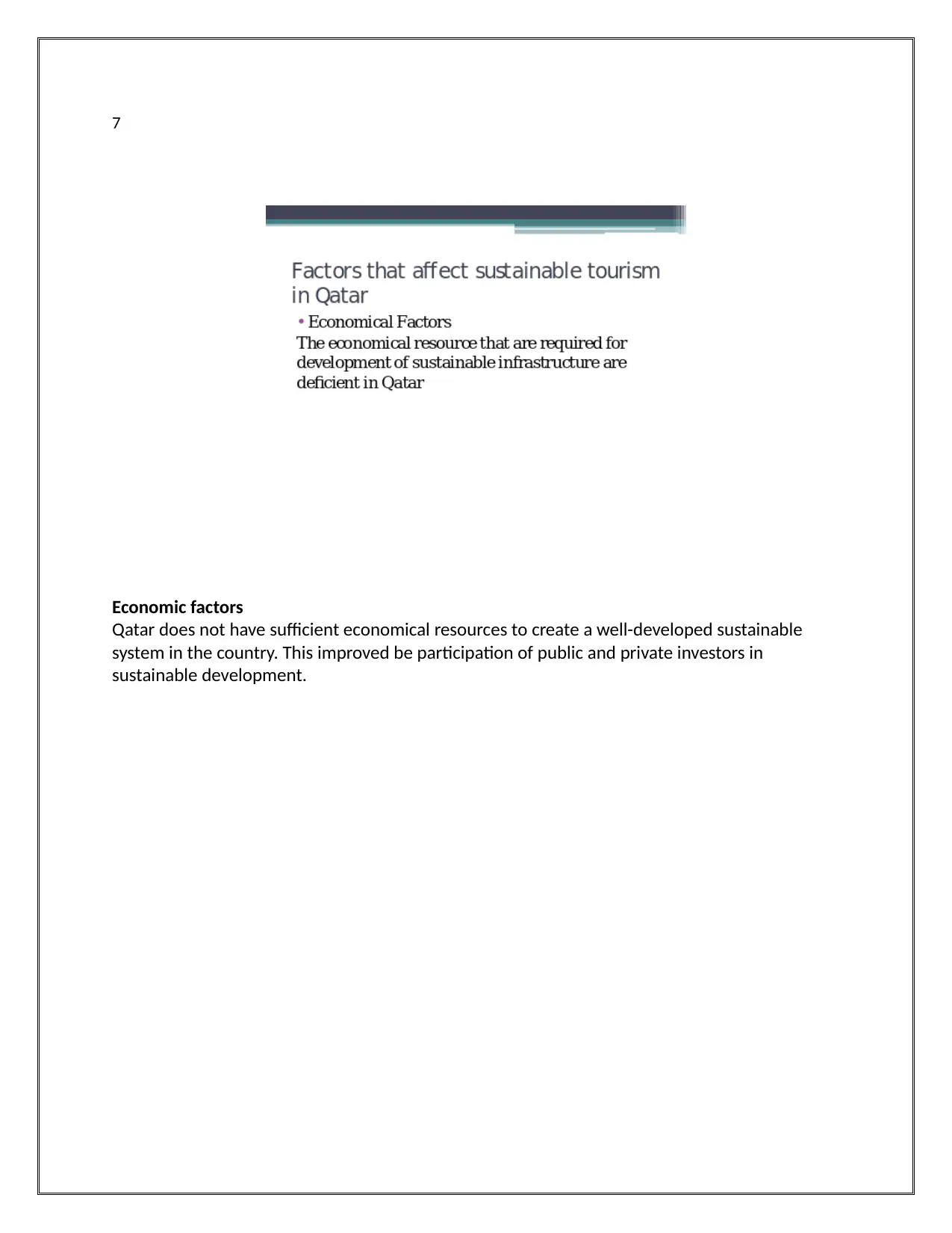
7
Economic factors
Qatar does not have sufficient economical resources to create a well-developed sustainable
system in the country. This improved be participation of public and private investors in
sustainable development.
Economic factors
Qatar does not have sufficient economical resources to create a well-developed sustainable
system in the country. This improved be participation of public and private investors in
sustainable development.
Paraphrase This Document
Need a fresh take? Get an instant paraphrase of this document with our AI Paraphraser
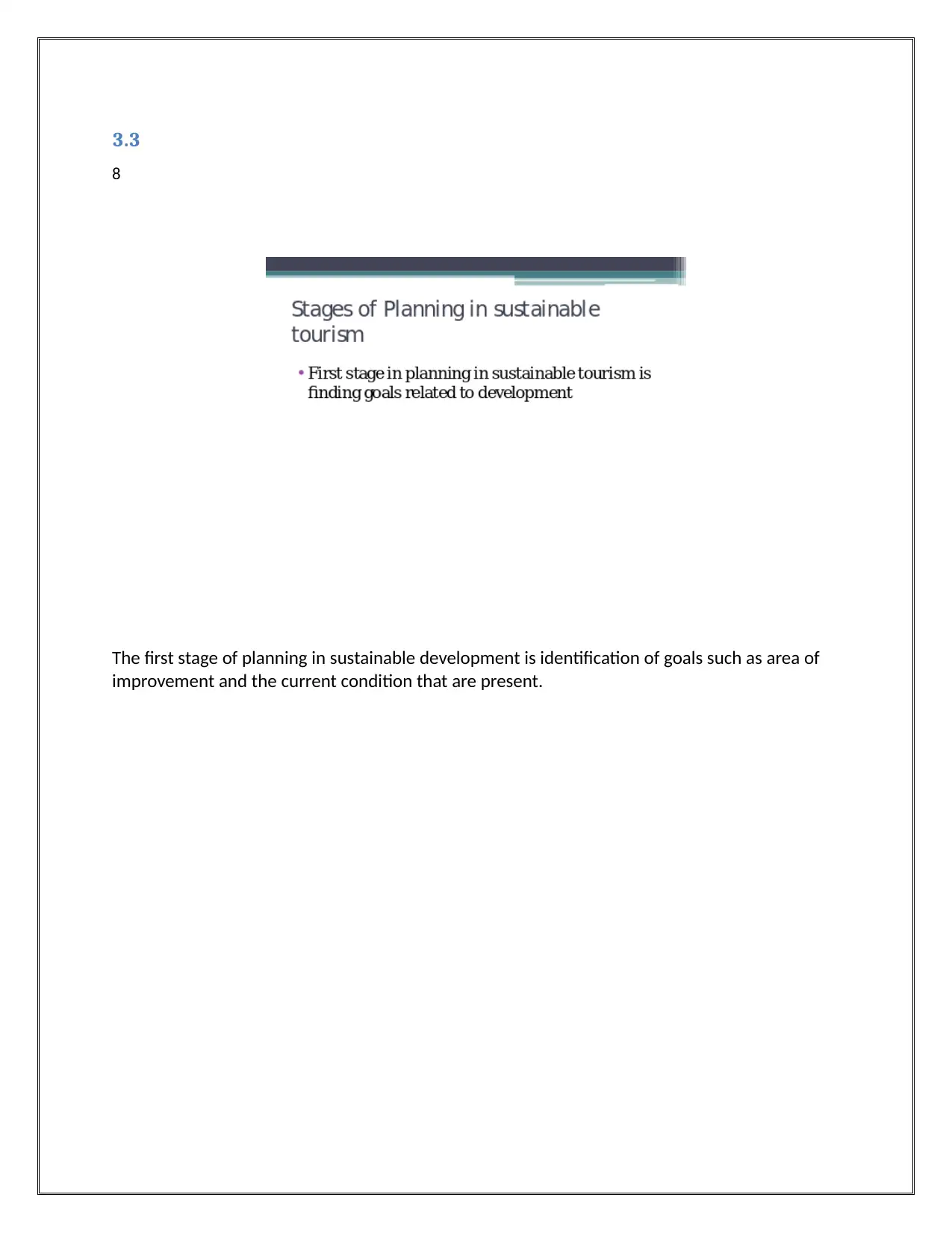
3.3
8
The first stage of planning in sustainable development is identification of goals such as area of
improvement and the current condition that are present.
8
The first stage of planning in sustainable development is identification of goals such as area of
improvement and the current condition that are present.
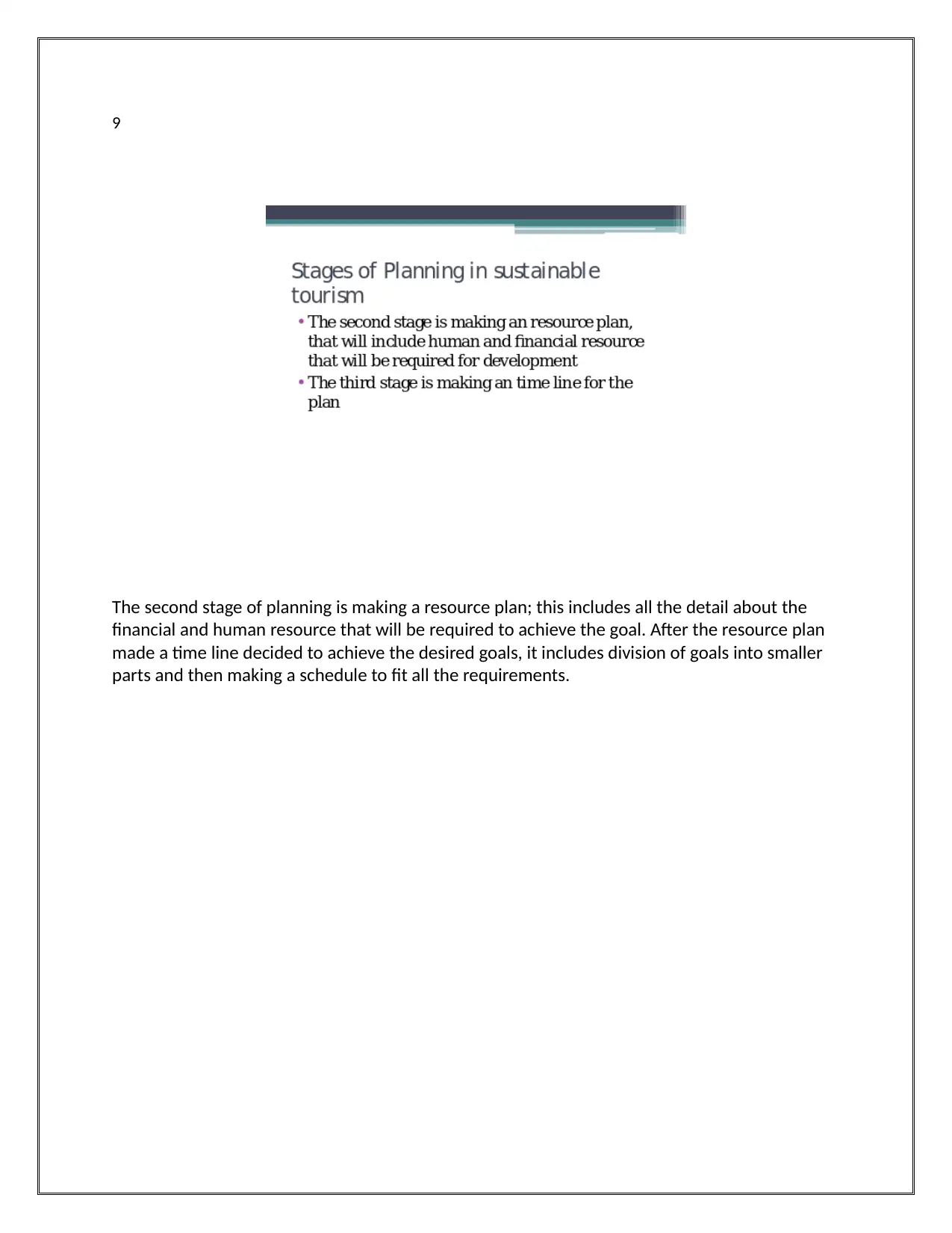
9
The second stage of planning is making a resource plan; this includes all the detail about the
financial and human resource that will be required to achieve the goal. After the resource plan
made a time line decided to achieve the desired goals, it includes division of goals into smaller
parts and then making a schedule to fit all the requirements.
The second stage of planning is making a resource plan; this includes all the detail about the
financial and human resource that will be required to achieve the goal. After the resource plan
made a time line decided to achieve the desired goals, it includes division of goals into smaller
parts and then making a schedule to fit all the requirements.
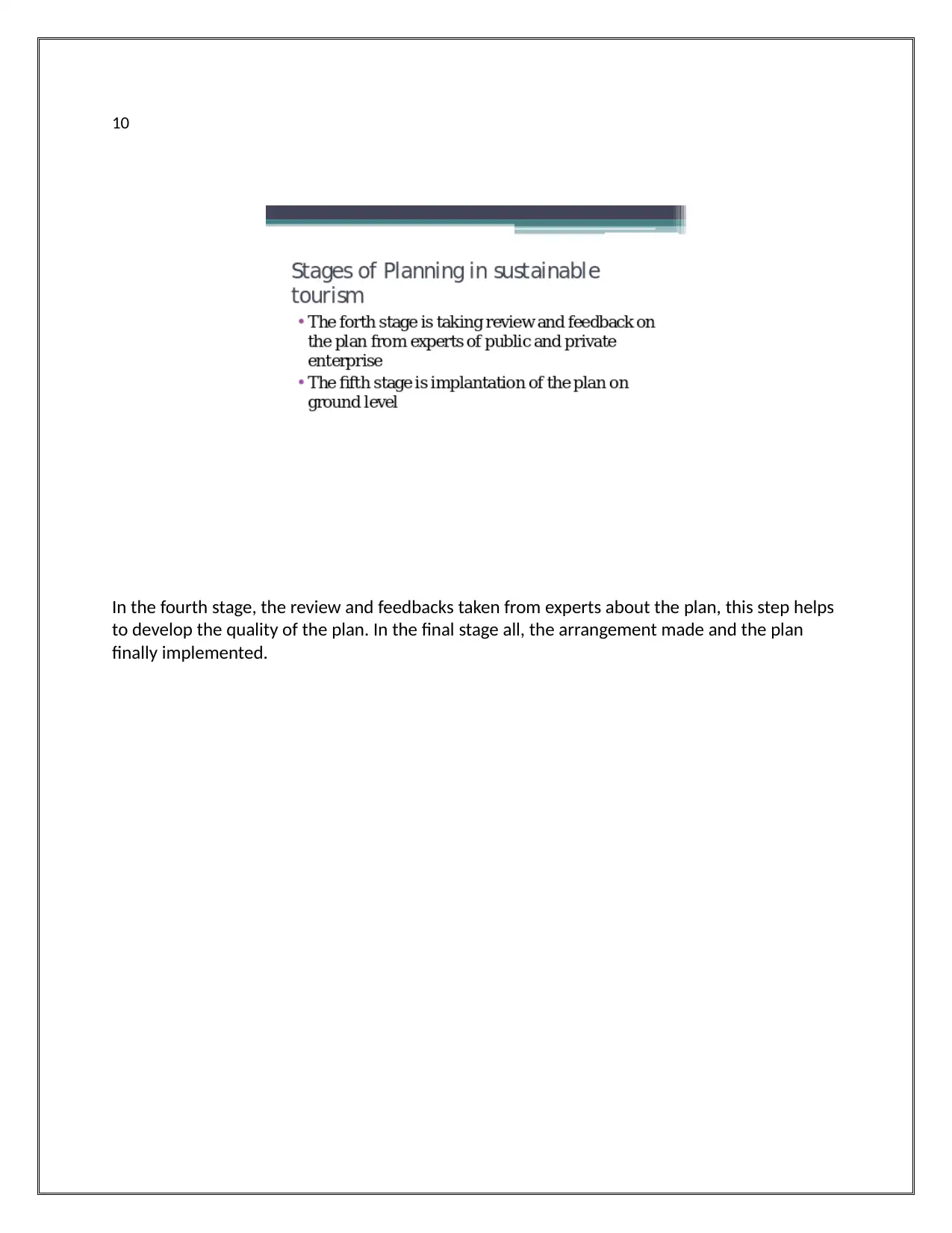
10
In the fourth stage, the review and feedbacks taken from experts about the plan, this step helps
to develop the quality of the plan. In the final stage all, the arrangement made and the plan
finally implemented.
In the fourth stage, the review and feedbacks taken from experts about the plan, this step helps
to develop the quality of the plan. In the final stage all, the arrangement made and the plan
finally implemented.
Secure Best Marks with AI Grader
Need help grading? Try our AI Grader for instant feedback on your assignments.
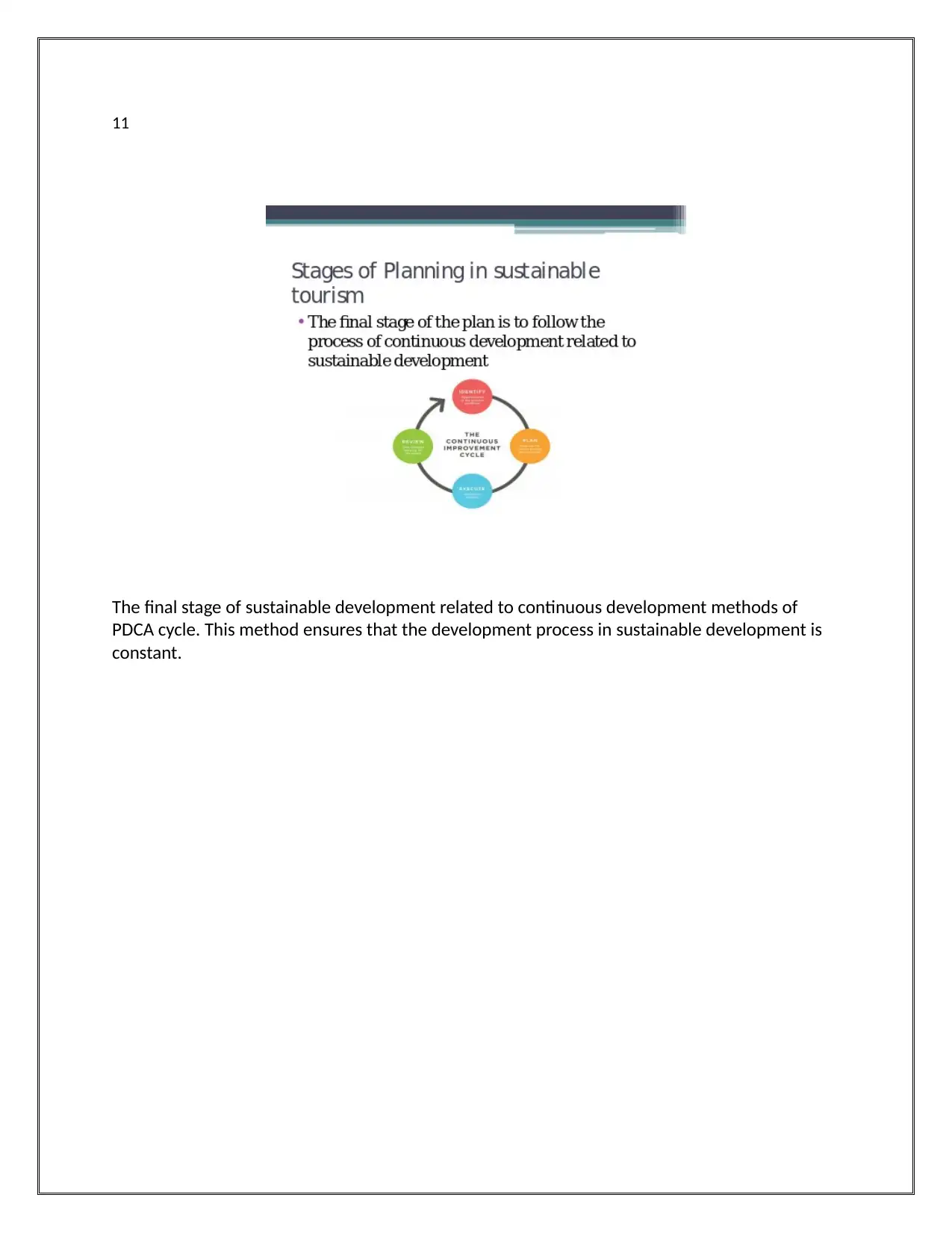
11
The final stage of sustainable development related to continuous development methods of
PDCA cycle. This method ensures that the development process in sustainable development is
constant.
The final stage of sustainable development related to continuous development methods of
PDCA cycle. This method ensures that the development process in sustainable development is
constant.
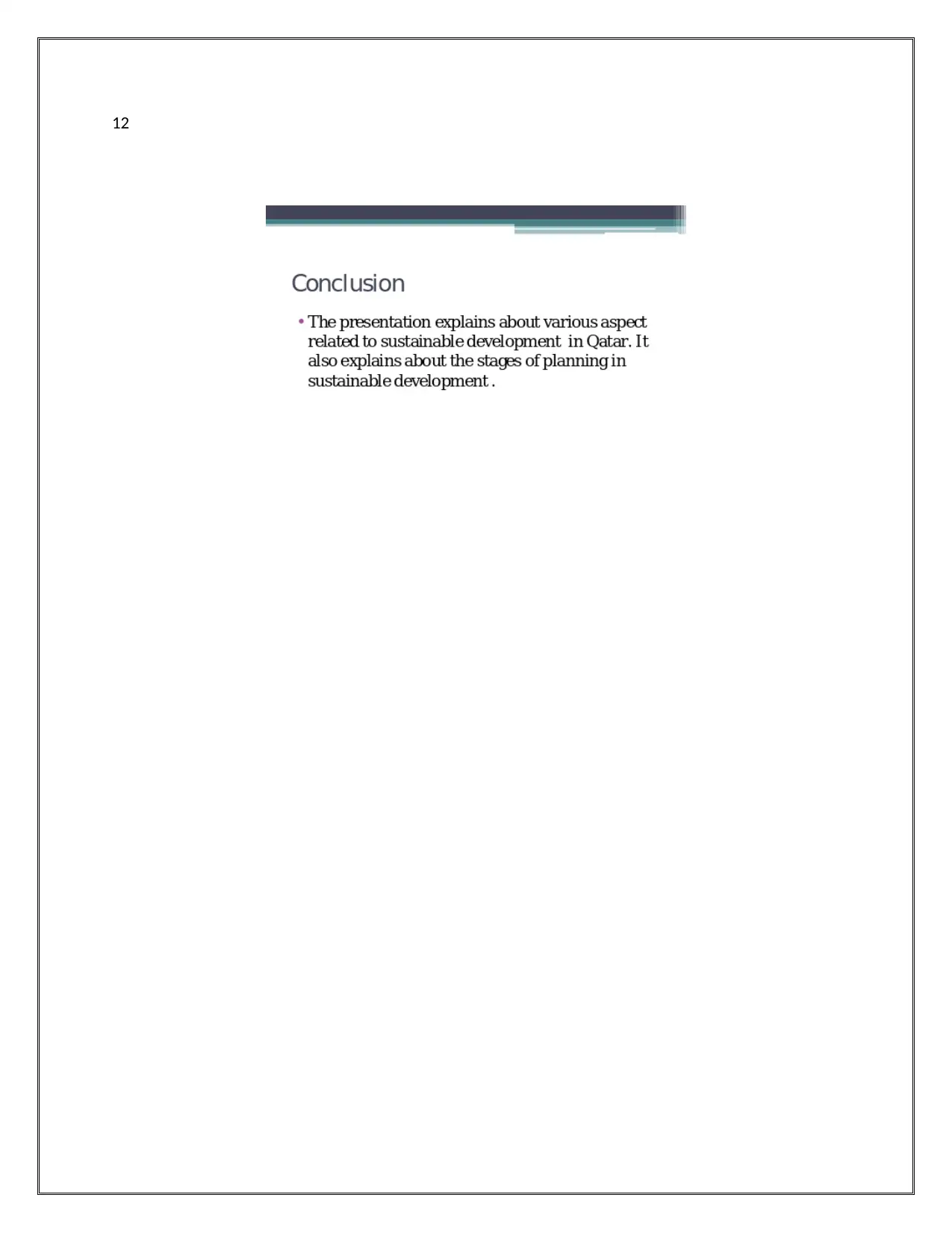
12
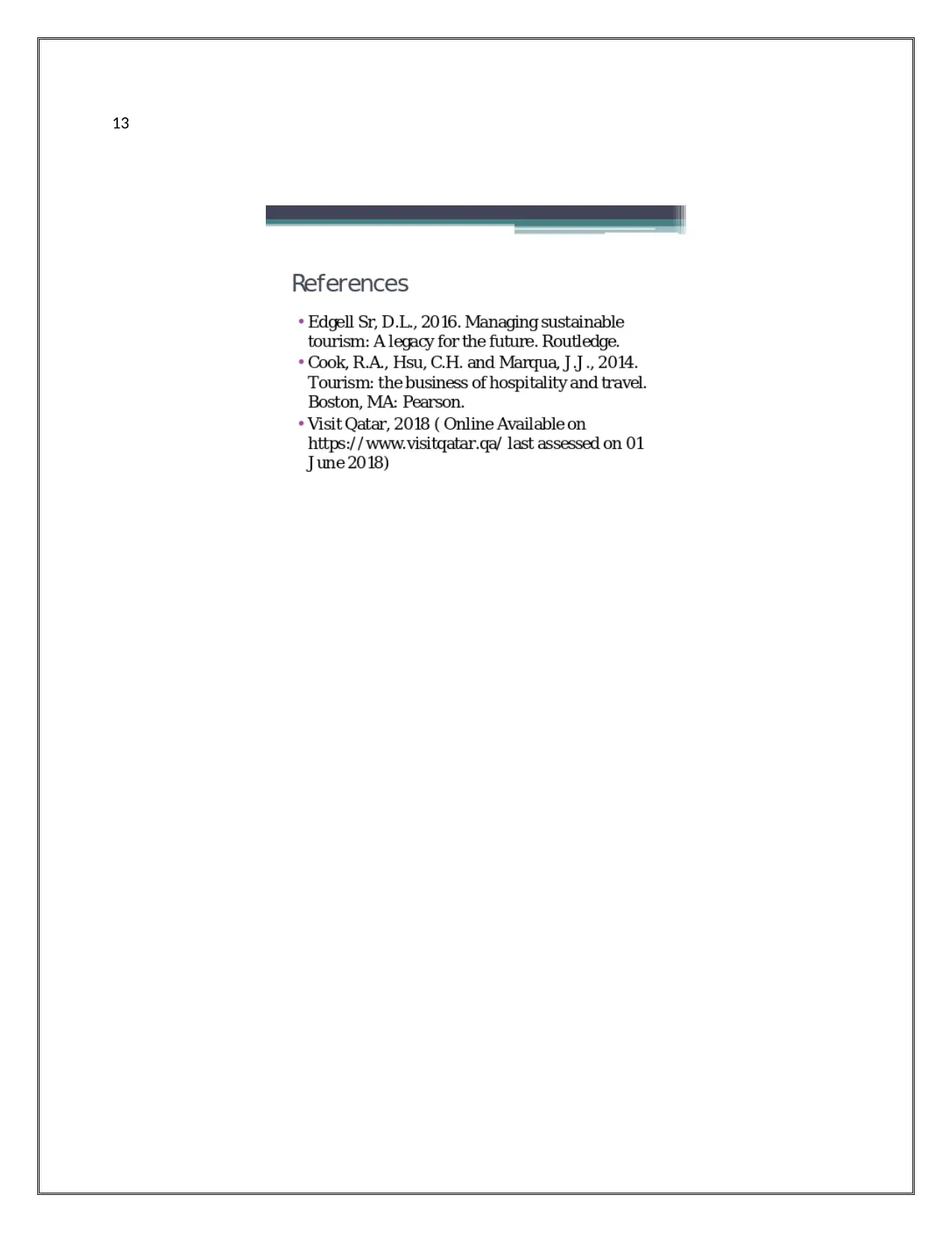
13
Paraphrase This Document
Need a fresh take? Get an instant paraphrase of this document with our AI Paraphraser
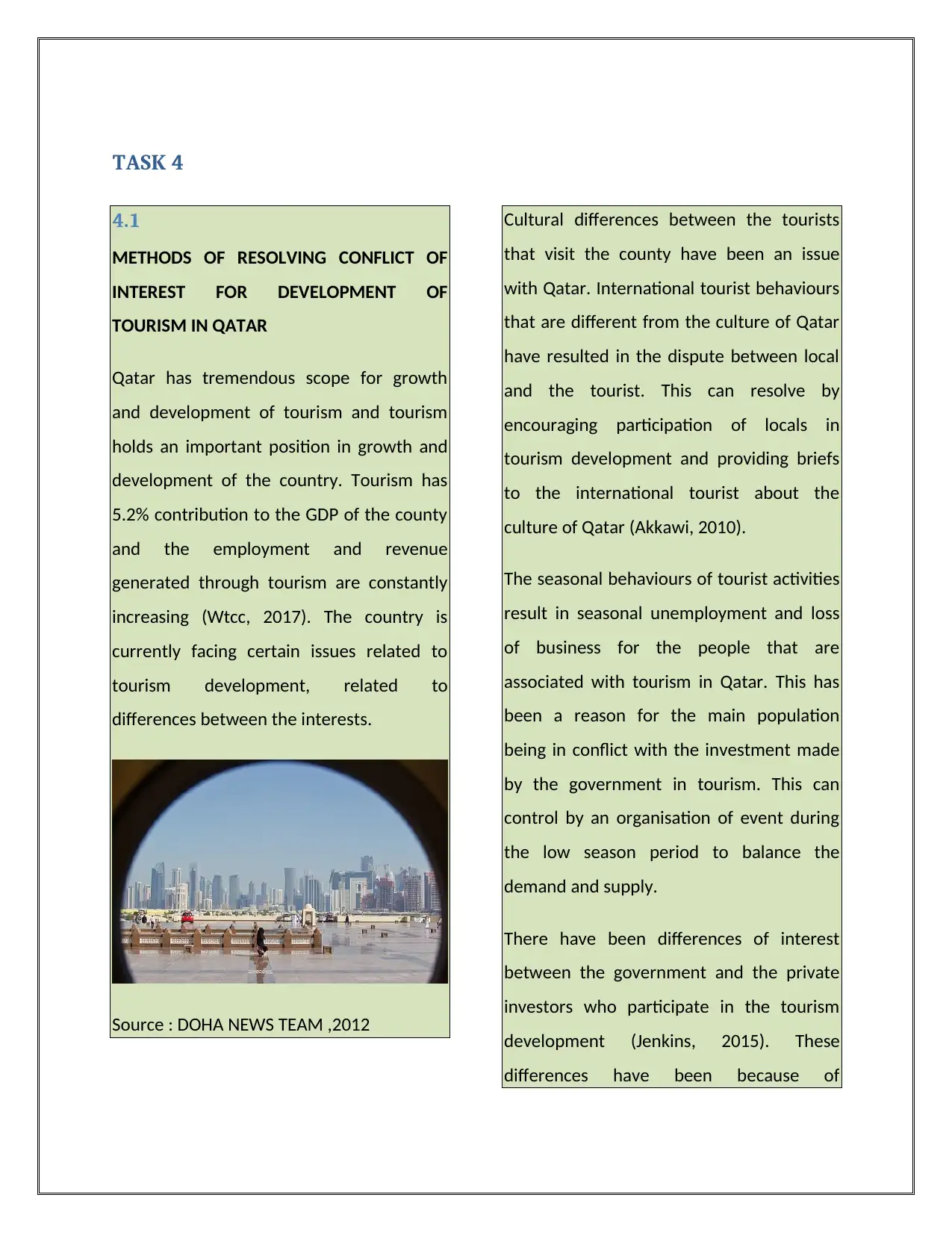
TASK 4
4.1
METHODS OF RESOLVING CONFLICT OF
INTEREST FOR DEVELOPMENT OF
TOURISM IN QATAR
Qatar has tremendous scope for growth
and development of tourism and tourism
holds an important position in growth and
development of the country. Tourism has
5.2% contribution to the GDP of the county
and the employment and revenue
generated through tourism are constantly
increasing (Wtcc, 2017). The country is
currently facing certain issues related to
tourism development, related to
differences between the interests.
Source : DOHA NEWS TEAM ,2012
Cultural differences between the tourists
that visit the county have been an issue
with Qatar. International tourist behaviours
that are different from the culture of Qatar
have resulted in the dispute between local
and the tourist. This can resolve by
encouraging participation of locals in
tourism development and providing briefs
to the international tourist about the
culture of Qatar (Akkawi, 2010).
The seasonal behaviours of tourist activities
result in seasonal unemployment and loss
of business for the people that are
associated with tourism in Qatar. This has
been a reason for the main population
being in conflict with the investment made
by the government in tourism. This can
control by an organisation of event during
the low season period to balance the
demand and supply.
There have been differences of interest
between the government and the private
investors who participate in the tourism
development (Jenkins, 2015). These
differences have been because of
4.1
METHODS OF RESOLVING CONFLICT OF
INTEREST FOR DEVELOPMENT OF
TOURISM IN QATAR
Qatar has tremendous scope for growth
and development of tourism and tourism
holds an important position in growth and
development of the country. Tourism has
5.2% contribution to the GDP of the county
and the employment and revenue
generated through tourism are constantly
increasing (Wtcc, 2017). The country is
currently facing certain issues related to
tourism development, related to
differences between the interests.
Source : DOHA NEWS TEAM ,2012
Cultural differences between the tourists
that visit the county have been an issue
with Qatar. International tourist behaviours
that are different from the culture of Qatar
have resulted in the dispute between local
and the tourist. This can resolve by
encouraging participation of locals in
tourism development and providing briefs
to the international tourist about the
culture of Qatar (Akkawi, 2010).
The seasonal behaviours of tourist activities
result in seasonal unemployment and loss
of business for the people that are
associated with tourism in Qatar. This has
been a reason for the main population
being in conflict with the investment made
by the government in tourism. This can
control by an organisation of event during
the low season period to balance the
demand and supply.
There have been differences of interest
between the government and the private
investors who participate in the tourism
development (Jenkins, 2015). These
differences have been because of
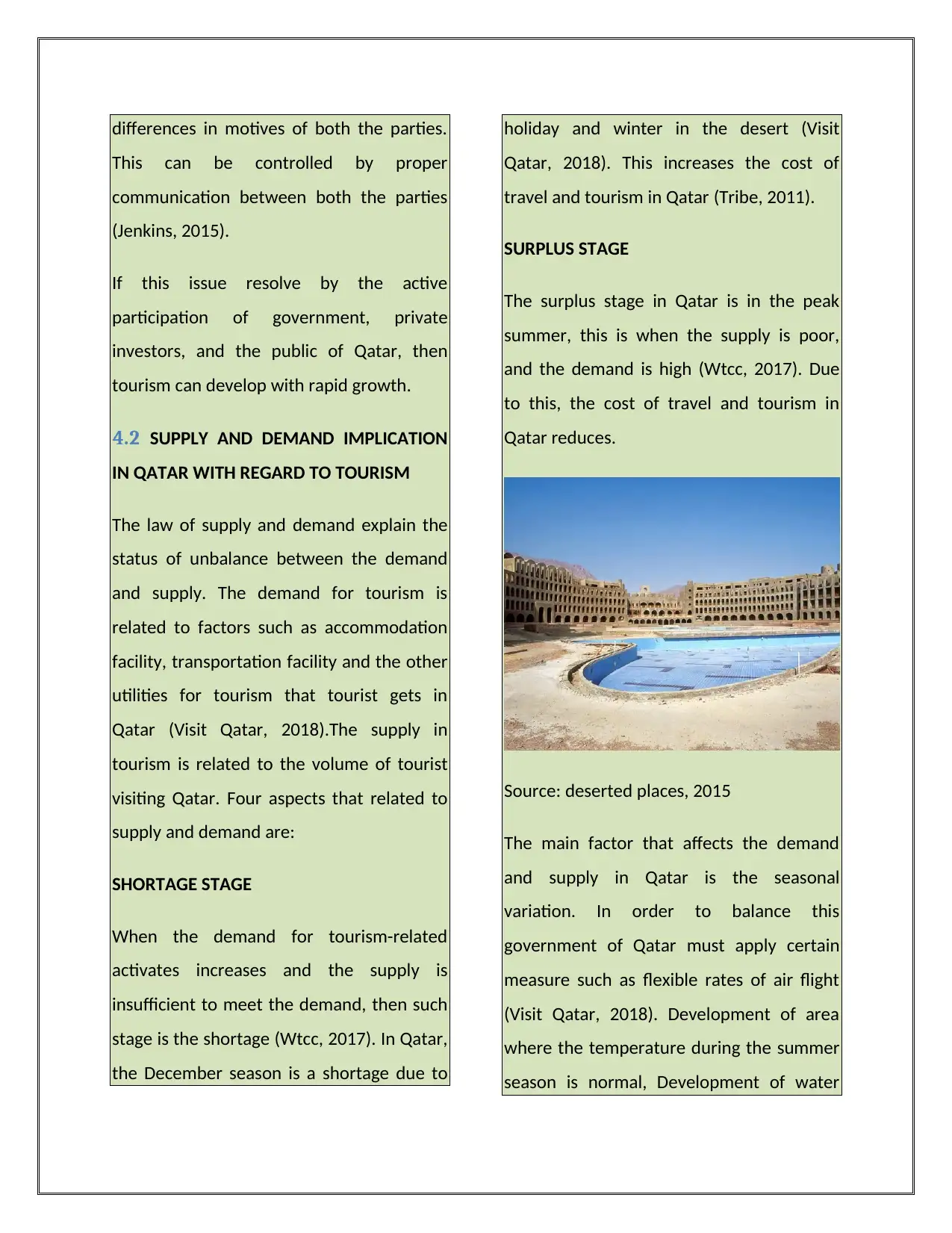
differences in motives of both the parties.
This can be controlled by proper
communication between both the parties
(Jenkins, 2015).
If this issue resolve by the active
participation of government, private
investors, and the public of Qatar, then
tourism can develop with rapid growth.
4.2 SUPPLY AND DEMAND IMPLICATION
IN QATAR WITH REGARD TO TOURISM
The law of supply and demand explain the
status of unbalance between the demand
and supply. The demand for tourism is
related to factors such as accommodation
facility, transportation facility and the other
utilities for tourism that tourist gets in
Qatar (Visit Qatar, 2018).The supply in
tourism is related to the volume of tourist
visiting Qatar. Four aspects that related to
supply and demand are:
SHORTAGE STAGE
When the demand for tourism-related
activates increases and the supply is
insufficient to meet the demand, then such
stage is the shortage (Wtcc, 2017). In Qatar,
the December season is a shortage due to
holiday and winter in the desert (Visit
Qatar, 2018). This increases the cost of
travel and tourism in Qatar (Tribe, 2011).
SURPLUS STAGE
The surplus stage in Qatar is in the peak
summer, this is when the supply is poor,
and the demand is high (Wtcc, 2017). Due
to this, the cost of travel and tourism in
Qatar reduces.
Source: deserted places, 2015
The main factor that affects the demand
and supply in Qatar is the seasonal
variation. In order to balance this
government of Qatar must apply certain
measure such as flexible rates of air flight
(Visit Qatar, 2018). Development of area
where the temperature during the summer
season is normal, Development of water
This can be controlled by proper
communication between both the parties
(Jenkins, 2015).
If this issue resolve by the active
participation of government, private
investors, and the public of Qatar, then
tourism can develop with rapid growth.
4.2 SUPPLY AND DEMAND IMPLICATION
IN QATAR WITH REGARD TO TOURISM
The law of supply and demand explain the
status of unbalance between the demand
and supply. The demand for tourism is
related to factors such as accommodation
facility, transportation facility and the other
utilities for tourism that tourist gets in
Qatar (Visit Qatar, 2018).The supply in
tourism is related to the volume of tourist
visiting Qatar. Four aspects that related to
supply and demand are:
SHORTAGE STAGE
When the demand for tourism-related
activates increases and the supply is
insufficient to meet the demand, then such
stage is the shortage (Wtcc, 2017). In Qatar,
the December season is a shortage due to
holiday and winter in the desert (Visit
Qatar, 2018). This increases the cost of
travel and tourism in Qatar (Tribe, 2011).
SURPLUS STAGE
The surplus stage in Qatar is in the peak
summer, this is when the supply is poor,
and the demand is high (Wtcc, 2017). Due
to this, the cost of travel and tourism in
Qatar reduces.
Source: deserted places, 2015
The main factor that affects the demand
and supply in Qatar is the seasonal
variation. In order to balance this
government of Qatar must apply certain
measure such as flexible rates of air flight
(Visit Qatar, 2018). Development of area
where the temperature during the summer
season is normal, Development of water
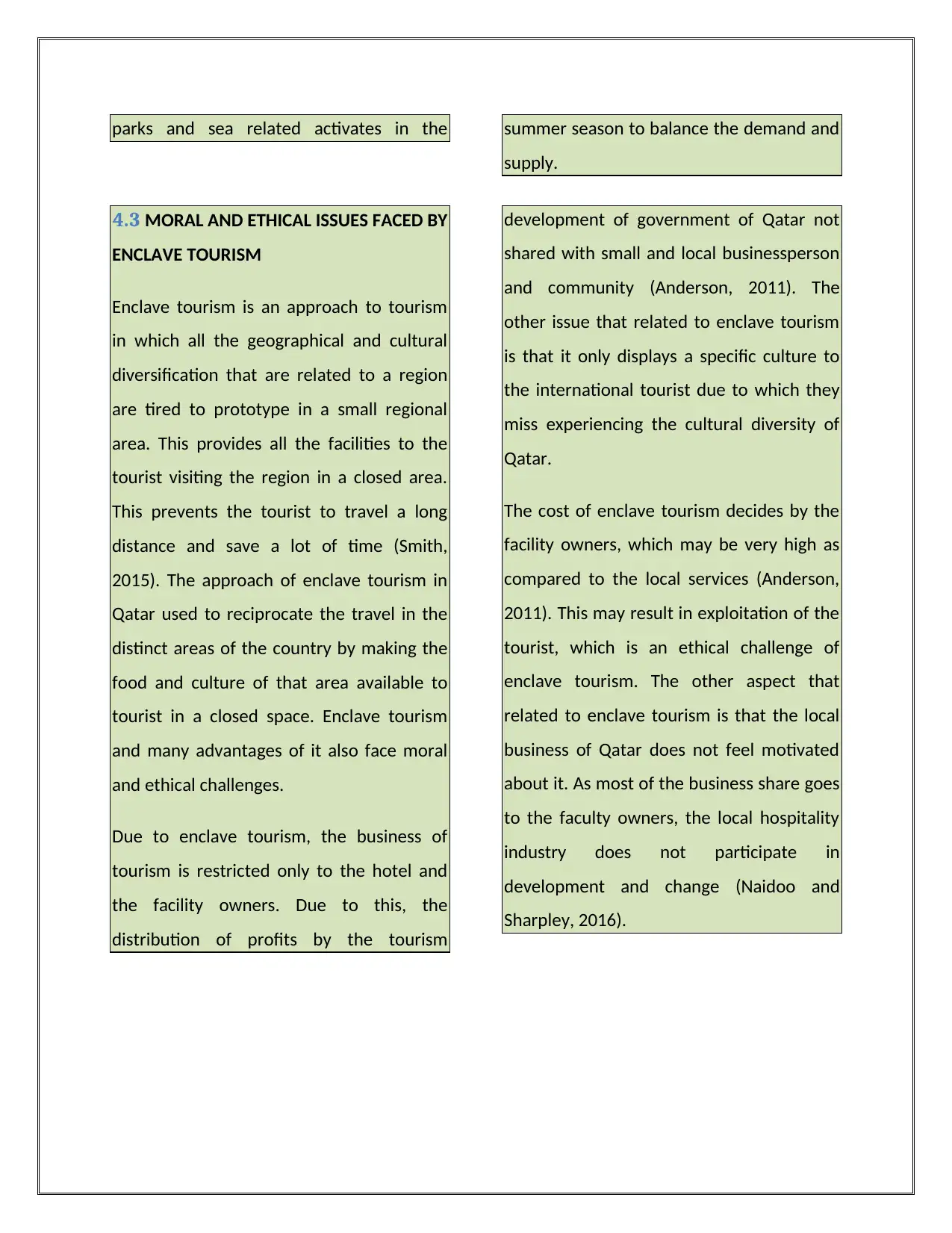
parks and sea related activates in the summer season to balance the demand and
supply.
4.3 MORAL AND ETHICAL ISSUES FACED BY
ENCLAVE TOURISM
Enclave tourism is an approach to tourism
in which all the geographical and cultural
diversification that are related to a region
are tired to prototype in a small regional
area. This provides all the facilities to the
tourist visiting the region in a closed area.
This prevents the tourist to travel a long
distance and save a lot of time (Smith,
2015). The approach of enclave tourism in
Qatar used to reciprocate the travel in the
distinct areas of the country by making the
food and culture of that area available to
tourist in a closed space. Enclave tourism
and many advantages of it also face moral
and ethical challenges.
Due to enclave tourism, the business of
tourism is restricted only to the hotel and
the facility owners. Due to this, the
distribution of profits by the tourism
development of government of Qatar not
shared with small and local businessperson
and community (Anderson, 2011). The
other issue that related to enclave tourism
is that it only displays a specific culture to
the international tourist due to which they
miss experiencing the cultural diversity of
Qatar.
The cost of enclave tourism decides by the
facility owners, which may be very high as
compared to the local services (Anderson,
2011). This may result in exploitation of the
tourist, which is an ethical challenge of
enclave tourism. The other aspect that
related to enclave tourism is that the local
business of Qatar does not feel motivated
about it. As most of the business share goes
to the faculty owners, the local hospitality
industry does not participate in
development and change (Naidoo and
Sharpley, 2016).
supply.
4.3 MORAL AND ETHICAL ISSUES FACED BY
ENCLAVE TOURISM
Enclave tourism is an approach to tourism
in which all the geographical and cultural
diversification that are related to a region
are tired to prototype in a small regional
area. This provides all the facilities to the
tourist visiting the region in a closed area.
This prevents the tourist to travel a long
distance and save a lot of time (Smith,
2015). The approach of enclave tourism in
Qatar used to reciprocate the travel in the
distinct areas of the country by making the
food and culture of that area available to
tourist in a closed space. Enclave tourism
and many advantages of it also face moral
and ethical challenges.
Due to enclave tourism, the business of
tourism is restricted only to the hotel and
the facility owners. Due to this, the
distribution of profits by the tourism
development of government of Qatar not
shared with small and local businessperson
and community (Anderson, 2011). The
other issue that related to enclave tourism
is that it only displays a specific culture to
the international tourist due to which they
miss experiencing the cultural diversity of
Qatar.
The cost of enclave tourism decides by the
facility owners, which may be very high as
compared to the local services (Anderson,
2011). This may result in exploitation of the
tourist, which is an ethical challenge of
enclave tourism. The other aspect that
related to enclave tourism is that the local
business of Qatar does not feel motivated
about it. As most of the business share goes
to the faculty owners, the local hospitality
industry does not participate in
development and change (Naidoo and
Sharpley, 2016).
Secure Best Marks with AI Grader
Need help grading? Try our AI Grader for instant feedback on your assignments.

TASK 5
5.1
ECONOMIC, SOCIAL, AND ENVIRONMENTAL IMPACT OF TOURISM IN QATAR AN EMERGING
COUNTY AND INDIA A DEVELOPING COUNTRY
Tourism development is associated with varieties if challenges that faced by the counties, these
challenges are related with the social, cultural, environmental challenges that are associated
with tourism.
India is a South Asian country that known for its cultural diversity and variation in the travel and
tourism experience. India is currently a developing country and chosen by many international
tourists for medical and cultural tourism.
The comparison between Qatar and India is as follows:
FACTOR QATAR INDIA
Social and Cultural
factors
In Qatar, International
tourist have been a prey of
many cons and criminals
There have been
differences due to culture
between tourist and the
citizen of Qatar
The social development has
been taking place to
support tourism
International tourist may
face challenges due to
the cultural diversification
in India
The social structure of
India supports tourism
development
The international tourist
have been highly charged
and subjected to cons
The government of the
country organises many
events to promote
5.1
ECONOMIC, SOCIAL, AND ENVIRONMENTAL IMPACT OF TOURISM IN QATAR AN EMERGING
COUNTY AND INDIA A DEVELOPING COUNTRY
Tourism development is associated with varieties if challenges that faced by the counties, these
challenges are related with the social, cultural, environmental challenges that are associated
with tourism.
India is a South Asian country that known for its cultural diversity and variation in the travel and
tourism experience. India is currently a developing country and chosen by many international
tourists for medical and cultural tourism.
The comparison between Qatar and India is as follows:
FACTOR QATAR INDIA
Social and Cultural
factors
In Qatar, International
tourist have been a prey of
many cons and criminals
There have been
differences due to culture
between tourist and the
citizen of Qatar
The social development has
been taking place to
support tourism
International tourist may
face challenges due to
the cultural diversification
in India
The social structure of
India supports tourism
development
The international tourist
have been highly charged
and subjected to cons
The government of the
country organises many
events to promote
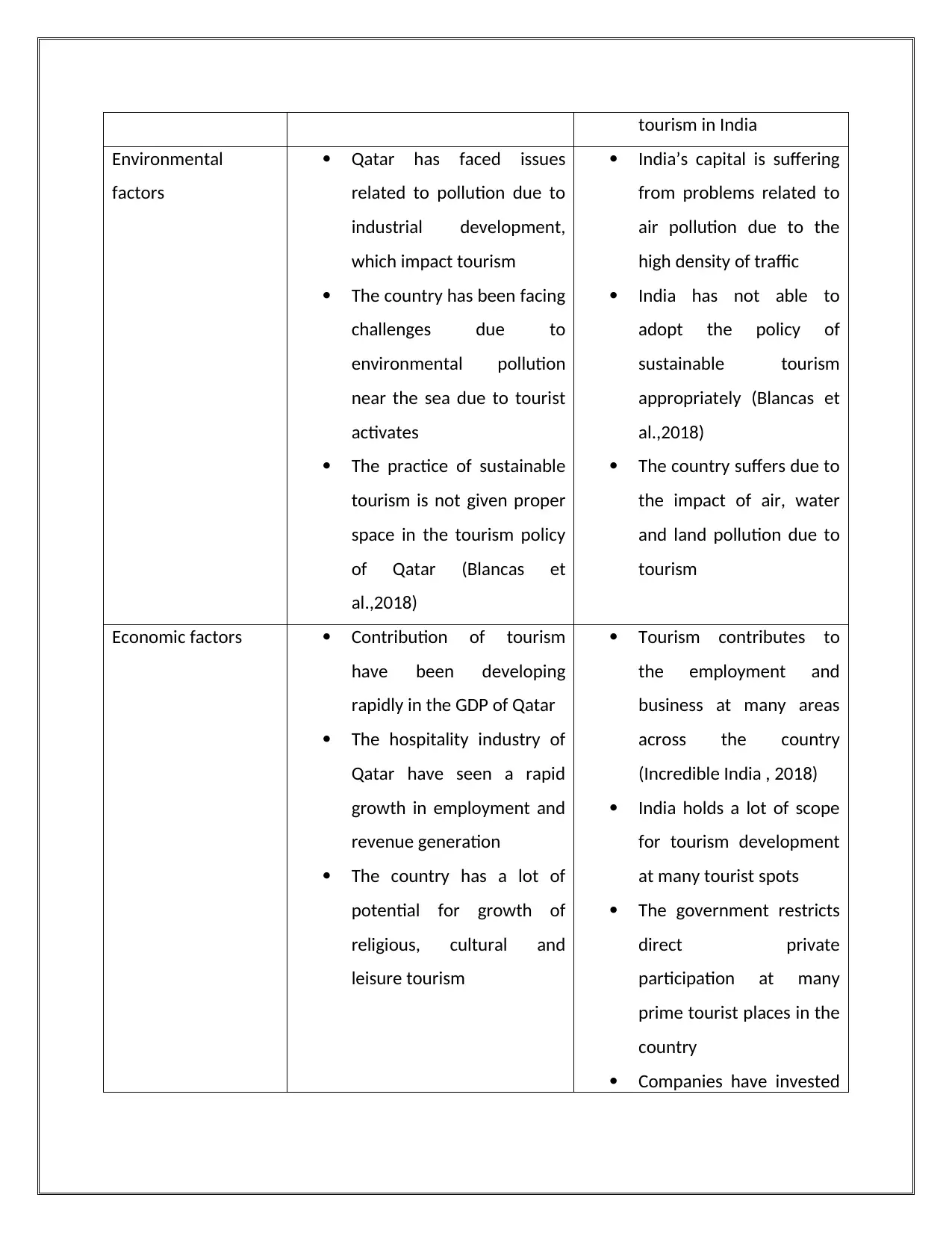
tourism in India
Environmental
factors
Qatar has faced issues
related to pollution due to
industrial development,
which impact tourism
The country has been facing
challenges due to
environmental pollution
near the sea due to tourist
activates
The practice of sustainable
tourism is not given proper
space in the tourism policy
of Qatar (Blancas et
al.,2018)
India’s capital is suffering
from problems related to
air pollution due to the
high density of traffic
India has not able to
adopt the policy of
sustainable tourism
appropriately (Blancas et
al.,2018)
The country suffers due to
the impact of air, water
and land pollution due to
tourism
Economic factors Contribution of tourism
have been developing
rapidly in the GDP of Qatar
The hospitality industry of
Qatar have seen a rapid
growth in employment and
revenue generation
The country has a lot of
potential for growth of
religious, cultural and
leisure tourism
Tourism contributes to
the employment and
business at many areas
across the country
(Incredible India , 2018)
India holds a lot of scope
for tourism development
at many tourist spots
The government restricts
direct private
participation at many
prime tourist places in the
country
Companies have invested
Environmental
factors
Qatar has faced issues
related to pollution due to
industrial development,
which impact tourism
The country has been facing
challenges due to
environmental pollution
near the sea due to tourist
activates
The practice of sustainable
tourism is not given proper
space in the tourism policy
of Qatar (Blancas et
al.,2018)
India’s capital is suffering
from problems related to
air pollution due to the
high density of traffic
India has not able to
adopt the policy of
sustainable tourism
appropriately (Blancas et
al.,2018)
The country suffers due to
the impact of air, water
and land pollution due to
tourism
Economic factors Contribution of tourism
have been developing
rapidly in the GDP of Qatar
The hospitality industry of
Qatar have seen a rapid
growth in employment and
revenue generation
The country has a lot of
potential for growth of
religious, cultural and
leisure tourism
Tourism contributes to
the employment and
business at many areas
across the country
(Incredible India , 2018)
India holds a lot of scope
for tourism development
at many tourist spots
The government restricts
direct private
participation at many
prime tourist places in the
country
Companies have invested

in tourism of India
5.2
RECOMMENDATION FOR TOURISM DEVELOPMENT IN QATAR AND INDIA
The suggestions for tourism development in Qatar are as follows:
The government of Qatar should organise events related to tourism in the offseason, to
reduce the impact of seasonal fluctuation of tourism in the country (Giampiccoli and
Mtapuri, 2015)
Initiative should be taken to promote participation of local community of Qatar in
hospitality of tourist
The government can offer discounts and faculties on flights to improve international
tourism to Qatar (Giampiccoli and Mtapuri, 2015)
Development of local routes and tourist spots along with their marketing should be
done the the government
The suggestions for tourism development in India are as follows:
To ensure proper connectivity between the tourist spots the government should
arrange routes for local and international tourist (Chhabra, 2017)
The government should take care that most of the tourist spots of the country are well
developed and they offer pleasant experience to all the tourist
To ensure food and hygiene safety , government must list and certify certain hotels for
international tourists
To encourage tourism the government should promote Indian tourism on internal scale
by marketing campaigns (Chhabra, 2017).
5.2
RECOMMENDATION FOR TOURISM DEVELOPMENT IN QATAR AND INDIA
The suggestions for tourism development in Qatar are as follows:
The government of Qatar should organise events related to tourism in the offseason, to
reduce the impact of seasonal fluctuation of tourism in the country (Giampiccoli and
Mtapuri, 2015)
Initiative should be taken to promote participation of local community of Qatar in
hospitality of tourist
The government can offer discounts and faculties on flights to improve international
tourism to Qatar (Giampiccoli and Mtapuri, 2015)
Development of local routes and tourist spots along with their marketing should be
done the the government
The suggestions for tourism development in India are as follows:
To ensure proper connectivity between the tourist spots the government should
arrange routes for local and international tourist (Chhabra, 2017)
The government should take care that most of the tourist spots of the country are well
developed and they offer pleasant experience to all the tourist
To ensure food and hygiene safety , government must list and certify certain hotels for
international tourists
To encourage tourism the government should promote Indian tourism on internal scale
by marketing campaigns (Chhabra, 2017).
Paraphrase This Document
Need a fresh take? Get an instant paraphrase of this document with our AI Paraphraser
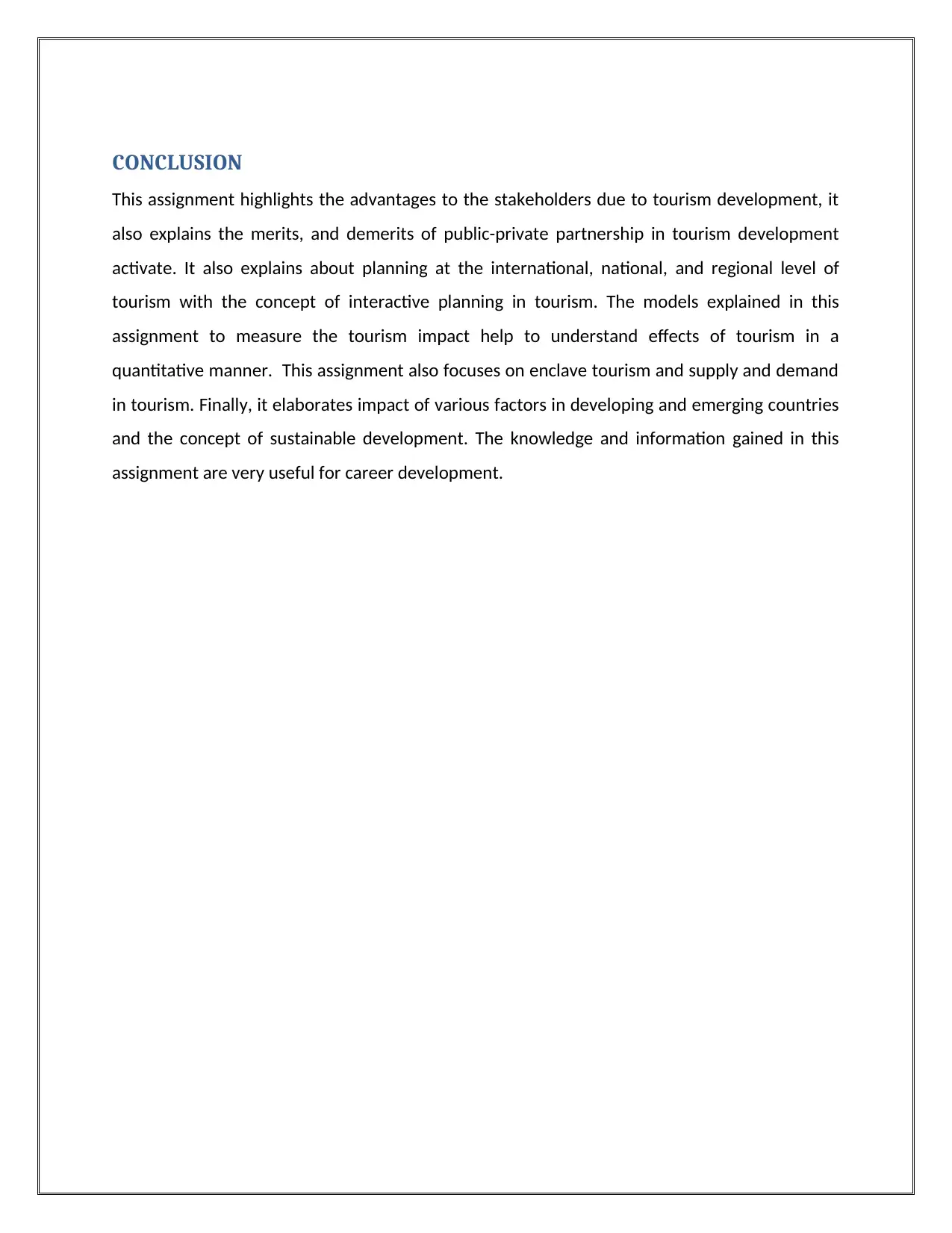
CONCLUSION
This assignment highlights the advantages to the stakeholders due to tourism development, it
also explains the merits, and demerits of public-private partnership in tourism development
activate. It also explains about planning at the international, national, and regional level of
tourism with the concept of interactive planning in tourism. The models explained in this
assignment to measure the tourism impact help to understand effects of tourism in a
quantitative manner. This assignment also focuses on enclave tourism and supply and demand
in tourism. Finally, it elaborates impact of various factors in developing and emerging countries
and the concept of sustainable development. The knowledge and information gained in this
assignment are very useful for career development.
This assignment highlights the advantages to the stakeholders due to tourism development, it
also explains the merits, and demerits of public-private partnership in tourism development
activate. It also explains about planning at the international, national, and regional level of
tourism with the concept of interactive planning in tourism. The models explained in this
assignment to measure the tourism impact help to understand effects of tourism in a
quantitative manner. This assignment also focuses on enclave tourism and supply and demand
in tourism. Finally, it elaborates impact of various factors in developing and emerging countries
and the concept of sustainable development. The knowledge and information gained in this
assignment are very useful for career development.

REFERENCES
Akkawi, M., 2010. Resident attitudes towards tourism development in conservative
cultures: The case of Qatar (Master's thesis, University of Waterloo).
Anderson, W., 2011. Enclave tourism and its socio-economic impact on emerging
destinations. Anatolia, 22(3), pp.361-377.
Blancas, F.J., Lozano-Oyola, M., González, M. and Caballero, R., 2018. A dynamic
sustainable tourism evaluation using multiple benchmarks. Journal of Cleaner
Production, 174, pp.1190-1203.
Chhabra, D., 2017. Heritage branding of India: a Gandhi tourism perspective. Annals of
Tourism Research, 62, pp.110-112.
Cook, R.A., Hsu, C.H. and Marqua, J.J., 2014. Tourism: the business of hospitality and
travel. Boston, MA: Pearson.
Cooper, C., 2012. Essentials of tourism. Pearson Financial Times/Prentice Hall.
Edgell Sr, D.L., 2016. Managing sustainable tourism: A legacy for the future. Routledge.
Faludi, A., 2013. A reader in planning theory (Vol. 5). Elsevier.
Giampiccoli, A. and Mtapuri, O., 2015. Tourism development in Qatar: Towards a
diversification strategy beyond the conventional 3 Ss.
Global tourism solutions, 2018 ( Online Available at
http://www.globaltourismsolutions.co.uk/steam-model last assessed on 02 June 2018)
Incredible India, 2018 ( Online Available at http://www.incredibleindia.org/index.php/e-
brochures last assessed on 03 June 2018)
Jenkins, C.L., 2015. Tourism policy and planning for developing countries: some critical
issues. Tourism Recreation Research, 40(2), pp.144-156.
Jucan, C.N. and Jucan, M.S., 2013. Travel and tourism as a driver of economic recovery.
Procedia Economics and Finance, 6, pp.81-88.
Moutinho, L. and Vargas-Sanchez, A. eds., 2018. Strategic Management in Tourism, CABI
Tourism Texts. Cabi.
Akkawi, M., 2010. Resident attitudes towards tourism development in conservative
cultures: The case of Qatar (Master's thesis, University of Waterloo).
Anderson, W., 2011. Enclave tourism and its socio-economic impact on emerging
destinations. Anatolia, 22(3), pp.361-377.
Blancas, F.J., Lozano-Oyola, M., González, M. and Caballero, R., 2018. A dynamic
sustainable tourism evaluation using multiple benchmarks. Journal of Cleaner
Production, 174, pp.1190-1203.
Chhabra, D., 2017. Heritage branding of India: a Gandhi tourism perspective. Annals of
Tourism Research, 62, pp.110-112.
Cook, R.A., Hsu, C.H. and Marqua, J.J., 2014. Tourism: the business of hospitality and
travel. Boston, MA: Pearson.
Cooper, C., 2012. Essentials of tourism. Pearson Financial Times/Prentice Hall.
Edgell Sr, D.L., 2016. Managing sustainable tourism: A legacy for the future. Routledge.
Faludi, A., 2013. A reader in planning theory (Vol. 5). Elsevier.
Giampiccoli, A. and Mtapuri, O., 2015. Tourism development in Qatar: Towards a
diversification strategy beyond the conventional 3 Ss.
Global tourism solutions, 2018 ( Online Available at
http://www.globaltourismsolutions.co.uk/steam-model last assessed on 02 June 2018)
Incredible India, 2018 ( Online Available at http://www.incredibleindia.org/index.php/e-
brochures last assessed on 03 June 2018)
Jenkins, C.L., 2015. Tourism policy and planning for developing countries: some critical
issues. Tourism Recreation Research, 40(2), pp.144-156.
Jucan, C.N. and Jucan, M.S., 2013. Travel and tourism as a driver of economic recovery.
Procedia Economics and Finance, 6, pp.81-88.
Moutinho, L. and Vargas-Sanchez, A. eds., 2018. Strategic Management in Tourism, CABI
Tourism Texts. Cabi.
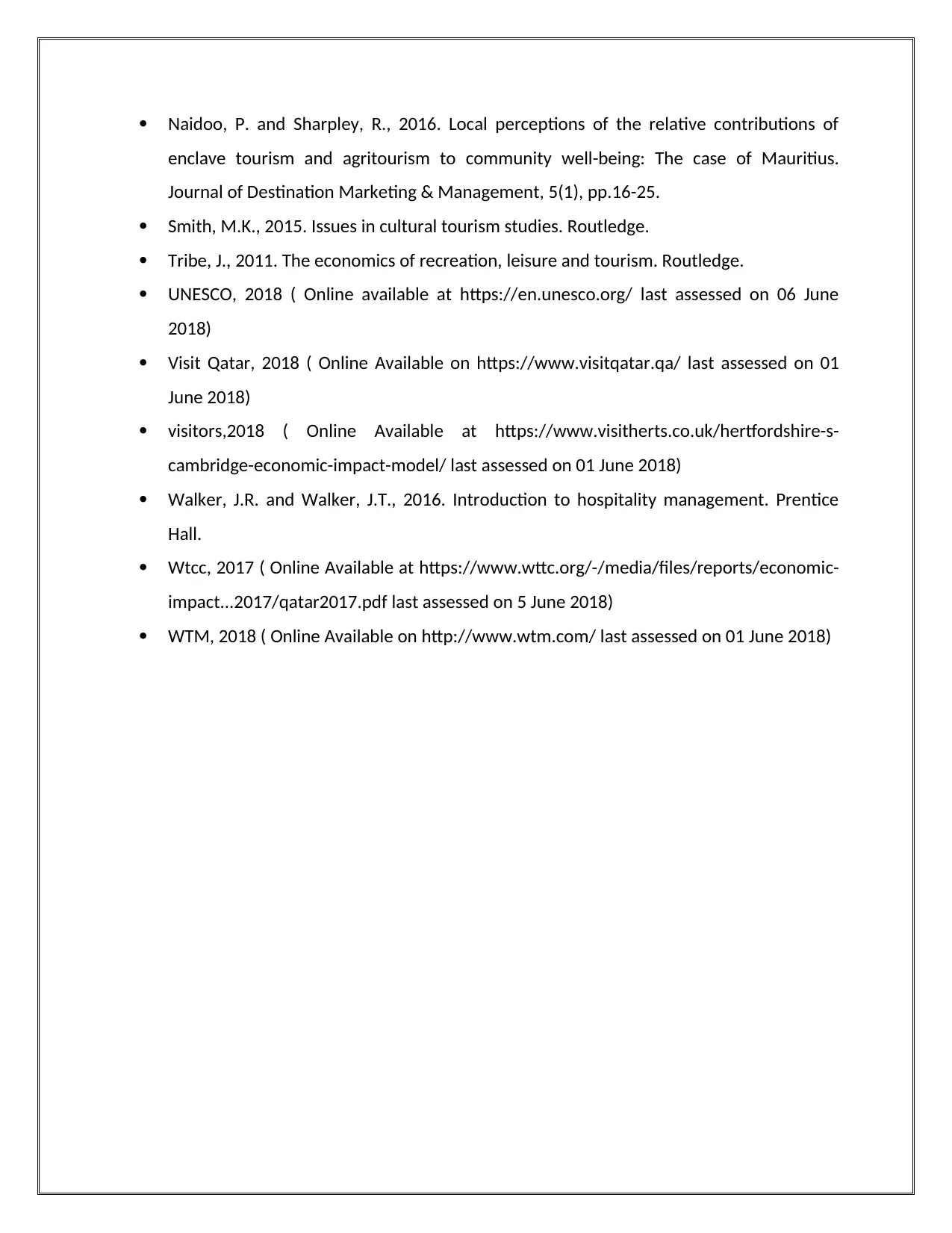
Naidoo, P. and Sharpley, R., 2016. Local perceptions of the relative contributions of
enclave tourism and agritourism to community well-being: The case of Mauritius.
Journal of Destination Marketing & Management, 5(1), pp.16-25.
Smith, M.K., 2015. Issues in cultural tourism studies. Routledge.
Tribe, J., 2011. The economics of recreation, leisure and tourism. Routledge.
UNESCO, 2018 ( Online available at https://en.unesco.org/ last assessed on 06 June
2018)
Visit Qatar, 2018 ( Online Available on https://www.visitqatar.qa/ last assessed on 01
June 2018)
visitors,2018 ( Online Available at https://www.visitherts.co.uk/hertfordshire-s-
cambridge-economic-impact-model/ last assessed on 01 June 2018)
Walker, J.R. and Walker, J.T., 2016. Introduction to hospitality management. Prentice
Hall.
Wtcc, 2017 ( Online Available at https://www.wttc.org/-/media/files/reports/economic-
impact...2017/qatar2017.pdf last assessed on 5 June 2018)
WTM, 2018 ( Online Available on http://www.wtm.com/ last assessed on 01 June 2018)
enclave tourism and agritourism to community well-being: The case of Mauritius.
Journal of Destination Marketing & Management, 5(1), pp.16-25.
Smith, M.K., 2015. Issues in cultural tourism studies. Routledge.
Tribe, J., 2011. The economics of recreation, leisure and tourism. Routledge.
UNESCO, 2018 ( Online available at https://en.unesco.org/ last assessed on 06 June
2018)
Visit Qatar, 2018 ( Online Available on https://www.visitqatar.qa/ last assessed on 01
June 2018)
visitors,2018 ( Online Available at https://www.visitherts.co.uk/hertfordshire-s-
cambridge-economic-impact-model/ last assessed on 01 June 2018)
Walker, J.R. and Walker, J.T., 2016. Introduction to hospitality management. Prentice
Hall.
Wtcc, 2017 ( Online Available at https://www.wttc.org/-/media/files/reports/economic-
impact...2017/qatar2017.pdf last assessed on 5 June 2018)
WTM, 2018 ( Online Available on http://www.wtm.com/ last assessed on 01 June 2018)
1 out of 34
Related Documents
Your All-in-One AI-Powered Toolkit for Academic Success.
+13062052269
info@desklib.com
Available 24*7 on WhatsApp / Email
![[object Object]](/_next/static/media/star-bottom.7253800d.svg)
Unlock your academic potential
© 2024 | Zucol Services PVT LTD | All rights reserved.





